
Marcus W. Robbins, Historian & Archivist
Copyright. All rights reserved.

Marcus W. Robbins, Historian & Archivist
Copyright. All rights reserved.
The United States Navy’s 240th Birthday
Dates matter to great institutions.
When you have worked at the modern day Norfolk Naval Shipyard (NNSY), a place where we take pride in claiming our founding date all the way back to November 1, 1767, you can’t help but to appreciate this institution’s great history and heritage. By operating under four different sovereign flags over 248 years, this location has served the nation well and is the home to some of our Navy’s leading accomplishments. One fact that should be not lost is that by our continuous operation as a shipyard the present day NNSY site is actually older than the Navy itself.
NNSY’s sole mission of SERVICE TO THE FLEET is to support the United States Navy, one of the most powerful institutions on earth. As I stated above, dates matter to great institutions and the United States Navy is no different.
October 13, 1775, is recognized as the official birthday of the United States Navy. I know of no better way to tell this story than to directly cite the following text taken from various portions of the Naval History and Heritage Command website where you can learn everything in great detail about our Navy’s rich tradition.
On Friday, October 13, 1775, meeting in Philadelphia, the Continental Congress voted to fit out two sailing vessels, armed with ten carriage guns, as well as swivel guns, and manned by crews of eighty, and to send them out on a cruise of three months to intercept transports carrying munitions and stores to the British army in America. This was the original legislation out of which the Continental Navy grew and as such constitutes the birth certificate of the navy.
Page of the "Journal of the Continental Congress"
containing the main part of the resolve
authorizing a Continental Naval Force, 13 October 1775.
Copied from the papers of the Continental Congress,
Record Group 360 in the National Archives.
NHHC Photograph Collection, NH 83601.The Continental Congress's resolution to procure two armed vessels, adopted in Philadelphia, Pennsylvania, on 13 October 1775, was the original legislation out of which the Continental Navy grew. Within a few days of that vote, Congress established a Naval Committee, which directed the purchasing, outfitting, manning, and operations of the first ships of the new Navy, drafted naval legislation, and prepared rules and regulations to govern the Navy's conduct and internal administration. Philadelphia was also the port where the purchase and outfitting of the first four vessels of the Continental Navy took place.
Because the Continental Navy began in Philadelphia on 13 October 1775, the Navy claims that date as its birthday. A logical corollary would be to recognize Philadelphia as the Navy's birthplace. The Navy, however, also honors the significant naval roles that many other towns played in the American Revolution and does not recognize any as its sole place of origin.
Over the course of the War of Independence, the Continental Navy sent to sea more than fifty armed vessels of various types. The navy's squadrons and cruisers seized enemy supplies and carried correspondence and diplomats to Europe, returning with needed munitions. They took nearly 200 British vessels as prizes, some off the British Isles themselves, contributing to the demoralization of the enemy and forcing the British to divert warships to protect convoys and trade routes. In addition, the navy provoked diplomatic crises that helped bring France into the war against Great Britain. The Continental Navy began the proud tradition carried on today by our United States Navy, and whose birthday we celebrate each year in October.Thus, the United States Navy was born and continues to serve this nation as the most powerful force in the world. A force for good and a force to keep the peace. On October 13, 2015 this proud institution we call our Navy shall turn 240 years old.
Please take time not only on that day but every day to thank a member of the United States Navy for their service to our country because – "history matters".SERVICE TO THE FLEET Turns 70 Years Old Today
It is with both pride and pleasure I share with you this notable commemoration as described in the title.
Seven decades of unwavering and faithful service bringing the news of the Norfolk Naval Shipyard waterfront into the hands of the untold thousands of workers and their families along with both the servicemen and women of the United States Navy that have been associated with America’s Shipyard is an honorable feat.
October 18, 1945, was a special day in this Shipyard’s long proud history because the newspaper we know in the present day as SERVICE TO THE FLEET made its first appearance under that masthead. A local newspaper is a like a family member, thus our birthday celebration and opportunity to trace its heritage.This name was born after a yard wide contest with consideration of thousands of entries by a committee consisting of a cross section of the yard in order to select a name that would best signify victory and keeping of the peace. Miss Erma D. Brinkley received a $100 Victory Bond donated by the Norfolk Navy Yard Co-Operative Association for her winning entry.
As mentioned in this edition we find the following explanation for the name change to SERVICE TO THE FLEET as the Norfolk Navy Yard already had hosted a weekly newspaper under two different names; first DEFENDER, then SPEED VICTORY for some few years prior."Conclusion of active warfare last August has brought many changes and now the name SPEED VICTORY goes out with many other war-time innovations. The name served its purpose well, providing a slogan as well as an appropriate title for a war-time paper which was distributed not only to each employee in the Navy Yard but was looked for with keen interest by thousands of servicemen and women stationed in all parts of the world".
As we would trace the genealogy of any 70 year old, it is best to start at the beginning…
For a very short run in 1920, there was a small format news monthly, THE CROW'S NEST followed by decades of inactivity for a regular published newsprint here at the Norfolk Navy Yard. This monthly publication featured various Shop news activities supplemented by local business advertising. It survives today only as a bound reproduced volume, yet it is quite insightful for the historical activities of the local workmen and how the yard proper and local area adapted after World War I.On March 4, 1942, with the advent of World War II, the local press awakens and under the guidance of Admiral Felix Gygax and a true weekly newspaper was born under the name of DEFENDER. Admiral Galax with his Shipyard Commander comments on the front page of this very first issue in part say:
"Today we launch the DEFENDER. Although it will not make as big a splash in the Elizabeth River, or in the public eye as the Alabama’s recent launching, it is, nevertheless, an event of major importance to the Norfolk Navy Yard. My cordial greetings and best wishes to the DEFENDER, our own newspaper".
That last comment of "our own newspaper" should not be lost. As was true back then with the call for correspondents from the various Shops to write copy, the same is true today for your interaction with the current Public Affairs Office. They want to hear of your deck plate successes!
Other thoughts from this first edition were "that it would chronicle the news of the yard, which means you and your fellow workers". Also stressed was the fact "that each worker is a defender, for each can play his part in the mighty effort that will be necessary to pave our way to victory". As the tide changed with the war, so did the name of our local newspaper to keep pace with the times.On November 24, 1943, after another yard wide naming contest, Mr. Carl Allen wins a $100 War Bond and our newspaper becomes SPEED VICTORY. With a masthead drawn by Mr. Kenn Niver of the Machinery Drafting Room, the paper continues to convey the news to our workforce that soon exceeds 43,000 men and women. This name would serve for the duration of the war until peace returned to the home front in 1945.
The magazine has seen many changes: from the frequency of issue from weekly to bi-weekly to monthly, to the various masthead artwork changes, to the physical format transition from a true newspaper broadside into a magazine style. This paper was almost always totally typeset in black and white for more than sixty years. The monthly color magazine format that we are all familiar with today, made its first appearance in May 2008, and continues to this day to tell the good news of America’s Shipyard.
Today, SERVICE TO THE FLEET provides insightful stories about the accomplishments about our employees. It features the work of the magnificent Norfolk Naval Shipyard industrial waterfront and continues to provide focus on the success stories of the complex Navy ships for which we provide world class repair service – "history matters".________
*The Norfolk Navy Yard DEFENDER, SPEED VICTORY, and SERVICE TO THE FLEET mastheads are kindly provided courtesy of Portsmouth Naval Shipyard Museum library. The Portsmouth Naval Shipyard Museum, located at 2 High Street in downtown Portsmouth, offers a unique perspective on U.S. and NNSY history from Colonial to Civil War times and beyond.
.
VISIONS OF THE PAST The Extension of Dry Dock # 3
Dry Dock #3 constructed (1903 to 1908) at 550’ total length soon became obsolete to support the newest class of battleships of the day. The dock was extended (1910 to 1911) to its present length of 723’-6". NNSY Historic Glass Plate Collection #719 taken on January 4, 1911, shows this progress. The Sheetmetal Shop, Building 56 sits where Building 1475 is located today.
As I prepare to publish the history of the Norfolk Naval Shipyard to celebrate the 250th anniversary (November 2017) there are so many interesting artifact objects, photographic images, postcards, period ledgers and maps that together tell our story. Some are rarely seen by the general public, until now.
USS Texas in Wooden Dry Dock #2
Dry Dock #2 was first constructed totally of wood (1889) and was rebuilt in concrete in 1933. It housed many of Uncle Sam’s finest including the nation’s first battleship, the USS Texas that was launched at the Norfolk Navy Yard on June 28, 1892. As seen here in this rare stereoview card from my personal collection, the USS Texas undergoes a maintenance docking at the Norfolk Navy Yard, circa 1900. The chimney of the old Foundry, Building 22 is seen in the distance as well as the boom and hook of the mid 1890’s steam engine portal crane.
USS Texas in Wooden Dry Dock 2 circa 1900As I prepare to publish the history of the Norfolk Naval Shipyard to celebrate the 250th anniversary (November 2017) there are so many interesting artifact objects, photographic images, postcards, period ledgers and maps that together tell our story. Some are rarely seen by the general public, until now.
USS Nashville 118 Years Ago Today
The USS Nashville was the first warship laid down at Newport News Shipbuilding & Drydock Company in 1894. It is seen here tied up at the Norfolk Navy Yard a few months after its commissioning exactly 118 years ago to this day (January 8, 1898) as inscribed on this rare cabinet card from my personal collection. This began a hand-in-hand relationship between the private and public yards to support the United States Navy fleet in our local area. Buildings or rooflines in the view (left to right) are 18, 22, 36, 37, 23 (as a one story then) 10, 705 & 33.
USS Nashville, Navy Yard, Norfolk, Va. Jan. 8th 1898
As I prepare to publish the history of the Norfolk Naval Shipyard to celebrate the 250th anniversary (November 2017) there are so many interesting artifact objects, photographic images, postcards, period ledgers and maps that together tell our story. Some are rarely seen by the general public, until now.Gate 3 Back in the Day, circa 1874
Today we view Gate 3 as an opening between the two very large independent structures (Buildings 19 & 51) that stand guard as a massive two story brick wall along Lincoln Street but it was not always so. This structure can trace it roots back to the pre-Civil War growth of the Gosport Navy Yard. Building 51 (right in view) was begun construction in 1849 to support Gunners and Sail Makers. It was closely followed in 1851-52 by the completion of Building 19 (left in view) which housed a Rigging Loft, Armory, Offices and the entrance gateway. The two were joined with a formal bell tower and presented an imposing formal look. This rare oversize stereoview card from my personal collection shows Marines inside of the Main Gate next to Trophy Park, circa 1874.
Excavation of Dry Dock #4 in 1917
Dry Dock #4 constructed (1917 to 1919) at 1,011’-10" total length was at one time the largest concrete structure in the world. As an open excavation trench with the actual dock formed within NNSY Historic Glass Plate Collection #1285 taken on August 30, 1917 shows early progress. The Structural Shop, Building 163 and the historic 1905 Marine Commandant’s home, M-1 home are also in the view.
And of course I had to conclude that first publication with one of my favorite pictures taken at Gosport in December of 1864, looking north from Dry Dock 1 showing the destruction from the Civil War
Excavation of Dry Dock #4 in 1917Snowfall at Quarters "A" in 1927
With everyone’s eyes looking at their smart phones to track the mid-Atlantic Blizzard of 2016 tonight, I thought I would share how historic Quarters "A" has seen snowfalls from the past. Snow is peaceful and pure and it makes the busy world so very quiet. NNSY Historic Glass Plate Collection #3297 & #3299 taken on January 11, 1927 shows Quarters "A", home of the Shipyard Commander and also a portion of historic Trophy Park under a white blanket from two different viewpoints. Today you can still experience these exact observations at America’s Shipyard because quality never changes.
As I prepare to publish the history of the Norfolk Naval Shipyard to celebrate the 250th anniversary (November 2017) there are so many interesting artifact objects, photographic images, postcards, period ledgers and maps that together tell our story. Some are rarely seen by the general public, until now.
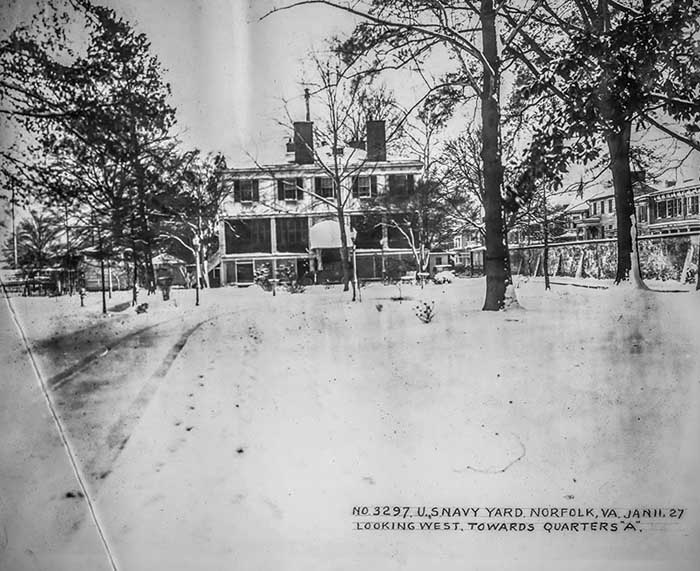
Left: Quarters "A" looking west before the lower porches were filled in (upper five windows were open porches at one time also). — at Norfolk Naval Shipyard (NNSY).
Right: Quarters "A" with all four of the original chimneys from 1837. Roofline is different today. — at Norfolk Naval Shipyard (NNSY).
Antiquated & Modern Fire Apparatus in 1919
Firefighting and fire prevention while keeping Uncle Sam’s fleet safe in this port is a job that the NNSY Fire Department has performed with both bravery and integrity for over two centuries going back to the days of setting watches and filling water buckets. NNSY Historic Glass Plate Collection #2418 & #2419 both taken late in the year of 1919 shows progression from horse drawn "antiquated" to gasoline truck "modern" fire apparatuses. Modern firefighting equipment has greatly evolved over the years with one notable difference; we don’t need to feed the "engine" oats and hay or scoop up after it.
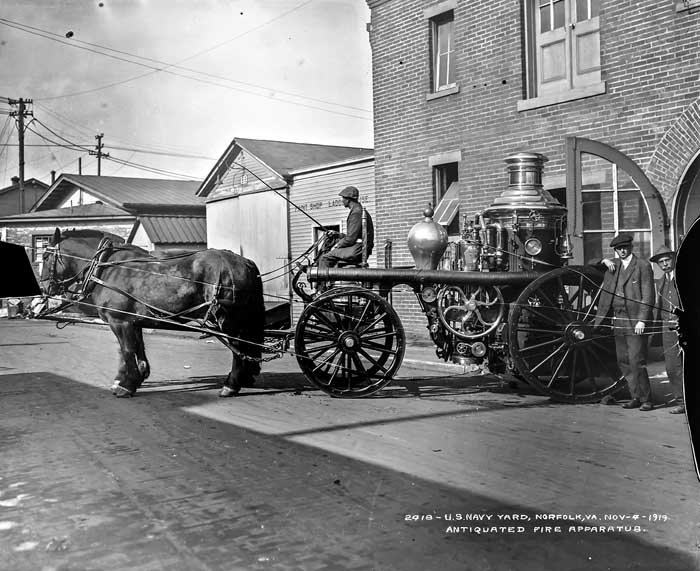
Left: Building 67, as the original Fire Station. — at Norfolk Naval Shipyard (NNSY).
Right: Berth 7 & 8 — at Norfolk Naval Shipyard (NNSY).Introduction to Blog #1
A few weeks ago Jennifer Zingalie, a Public Affairs Specialist working in the NNSY Public Affairs Office (PAO), asked me if I would be interested in creating and maintaining material for a consistent historical look at our shipyard's history for posting on NNSY's Facebook page. Well, it did not take me long to positively respond, as if any of you know me personally, history within the walls and gates of this Navy Yard in the last few years has become my passion. We have a great story to tell. I am a firm believer and have said many times "you must know where you came from in order to know where you are going". My friends, this will be the first of many postings to share Norfolk Naval Shipyard's rich and interesting historical heritage.
It will be a journey that expands on unique little known facts taken and explored from the larger story of this great institution, our Norfolk Naval Shipyard. It will be a journey to gain insight of the people, the facilities and the vast waterfront that has served our country for the last 244 years from its humble beginnings on the banks of the Elizabeth River when first founded 1 November, 1767. Today we walk over history, we work under the roof of history, and we owe it to future generations to tell the story.
To honor those that have recorded the story about our shipyard's history, beginning with published accounts going back into the 19th century, I will bring together facts and various quotes from the writings of those great authors that have gone before me, chiefly being Commander Edward Lull, Lieutenant Commander Simon Barksdale, Technical Librarian Marshall Butt and Public Affairs Officer Joe Law. Their collection of works and reference materials document our earliest beginnings and will provide unlimited opportunities. I too shall provide unique insight and materials from my own personal collection of newspapers and periodical materials that document our work establishment environment, especially the 18th and 19th centuries. My emphasis mostly shall focus on the old Gosport Navy Yard (from late 1700's) to the end of the Norfolk Navy Yard period (mid 1940's).
Who am I and what creditability do I have to speak on our history? My name is Marcus W. Robbins and I was born and raised locally in Norfolk Virginia. Upon graduation from Norview High School I found myself in Public Works, Shop 07 with an apprenticeship being trained as a Welder in the fall of 1977. After 4 years of waterfront time and trade theory with Shop 26, my career has been involved around Public Works either working with my tools as a Journeyman Welder, serving as a Planner & Estimator, serving as an Engineering Technician in the Facilities Support Contracts Division, serving staff to the Public Works Officer as a Facilities Maintenance Specialist and most recently my career has lead me to NNSY Code 1100 as the Command Facilities Program Manager.
The reoccurring theme of "my work life" is our NNSY facilities. I know these grounds and facilities well, along with how they have historically performed their functions by personal observation these 33 years.
Our people do a good work and I have seen many changes at this establishment over the years. Our people have a story to tell, your family members have a story to tell. Together I want to help tell their story because, "history matters".
Photographer: Gardner. Circa 1864.
Norfolk Navy Yard ruins, looking north from
Drydock 1. Ex-building 18 in the near view.Historical Events Do Tell a Story at NNSY
Our Norfolk Naval Shipyard lives on today because of the proud accomplishments of not only its past but its promise of the future. It is so very important that new employees here learn of the great milestones we accomplished here on the southern branch of the Elizabeth River, not only for the Navy but for the United States. The one thing I try to tell everyone is history is not just something abstract that happened in the past. The history of our shipyard going into the future depends on you also, the new employee "you must own it".
The historical events story of the Norfolk Naval Shipyard are like a great tapestry; it is woven of many individual fibers all coming together to create something larger. Those fibers begin with our people as they demonstrate pride, knowledge and the craftsmanship of the shipbuilding and repair. Those fibers are the tools used and raw materials that are transformed into ships and equipment. Those fibers are the facilities and buildings that are utilized to bring everything together in order to deliver a world class product.
Norfolk Naval Shipyard delivers world class products as evidenced by our motto – "Any Ship, Any Time, Any Where".
One of the best physical artifact tools for learning and teaching a quick overview of our historical events at the Norfolk Naval Shipyard is the bronze plaque inside of Gate 10. I often take new employees there or advise the more seasoned ones to take time to go read what they have driven past for years. It was erected by the Norfolk Naval Historical Association in 1950 with the very mission of telling our story because – "history matters."
Bronze plaque erected in 1950 (located inside of Gate 10) at Norfolk Naval Shipyard.
Text sourced from "A Brief History" by Marshall W. Butt April 1951.
Dry Dock #2 Was First a Wooden Dock
In 1887 to meet the growing needs of the America’s new steel navy it was necessary for the Norfolk Navy Shipyard to construct Dry Dock #2. As a completely wooden dock it was completed in 1889 and served in this capacity till it was modernized for the first time in 1933 as it transitioned into a concrete dock. It later went under a huge renovation including the distinctive sonar pit in 1964 as the Norfolk Naval Shipyard transitioned into the nuclear submarine age.
The USS Texas is shown in this dock, circa 1905 as it was America’s first battleship. This image is from the collection of the Portsmouth Public Library. Note the various brace logs, dockings were a much more complicated item back in the day due to narrow keels.
Also below from the NNSY Historic Glass Plate Collection #0154 is an image taken from the year of 1901 and shows a localized repair of the dock’s wall from a bulging condition. It is amazing that this dock functioned as built for over 45 years without substantial repairs.
Dry Dock #2 gave our nation service for both the Spanish American War and World War I as a wooden dock. It continues to provide service today almost 130 years later with the same wooden foundation piles because we build our facilities to stand up for the ages.
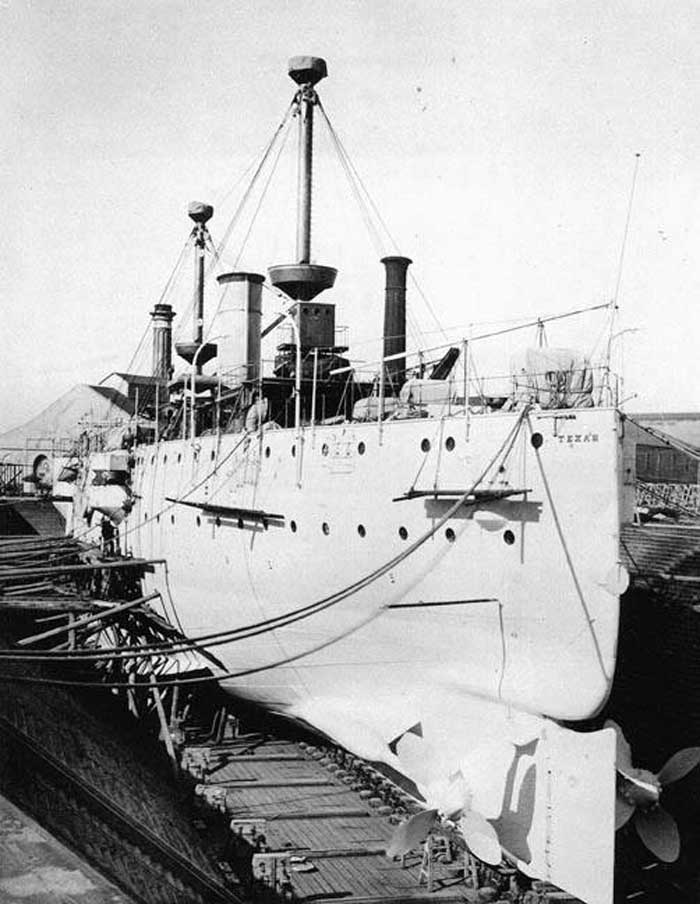
USS Texas in Dry Dock #2, circa 1905. Image courtesy of Portsmouth Public Library.
Historic Norfolk Navy Yard Glass Plate Collection # 154, circa 1901 at Dry Dock #2
Vision 11, February 29, 2016The 1893 Station Map
Maps are a Historian’s window on the past. The 1893 Norfolk Navy Yard station map is one of our true classics. The original survives and is amazing to view in person. You can learn so much of the thought process that went into our facility layout of 150 years ago because it has remained basically unchanged. That is because we have facilities that were built to last to support our Navy.
As everyone knows I am a facility guy; rooflines, railroad trackage and building foundations are my thing. You can see in this 1893 map that the short line railroad track network is now fully complete including crossing the 1850’s railroad trestle from Building 39 to 31. The first traveling portal crane track has been placed around the new 1889 wooden Dry Dock #2 which supports our first steam driven dock crane. The 1840’s stone bridge at the entrance to the Timber Dock has not yet been removed (1900) as it provided a straight roadway from the entrance gate towards the docks.
While some of the facilities were removed as we modernized the layout is basically the same. I do wish to call your attention to the east of the Mast House (Building 28) and near the Marine Railway as we have one facility that was an everyday necessity that had no real glory but was used by everyone. Facility #26, the Water Closets were a short pier with a wooden shelter over a simple wooden bench with holes dropping over the open water. As I stated before maps are a window on the past and now you know something you did not know before about "real" shipyard life in 1893.
February 29, 2016, by Marcus W. Robbins
The 1893 Station MapArtifacts Relating to Battle of Hampton Roads ~ March 8 & 9, 1862 . . .
The other day I had a chat with my friend John V. Quarstein whom is indeed the world’s best source of knowledge regarding the famous naval engagement that has become known as the Battle of Hampton Roads. This event occurred on March 8 & 9, 1862 in our own local waters. We were discussing being retired from our first jobs and now pursuing our real passion as Historians and he concluded with "You and I have the best jobs in the world". Pretty cool comment from such a respected naval author, I smiled.
I do have a pretty cool job and personal hobby as it allows me to do deeper research and see many off exhibit objects the general public shall never witness in person. I would like to thank the Mariners’ Museum for allowing me to view all four of their original pen on linen long scroll drawings of John Luke Porter’s radical design to convert the burnt and sunken USS Merrimac into what would become the CSS Virginia a few months ago. Those very drawings Porter created with his own hand were pulled out of storage especially for me to view on a large table, it was a day I shall never forget. These drawings were penned within our shipyard walls in 1861.
The present day Norfolk Naval Shipyard then known as the Gosport Shipyard while under Confederate control created the world’s first ironclad vessel. Porter was the Naval Constructor for the entire Confederacy by operating out of Gosport. We changed forever modern naval warfare right here in Portsmouth, Virginia on the Southern Branch of the Elizabeth River as one of our many historic "first accomplishments".
While no cameras captured the images of the either day of the Battle of Hampton Roads how cool is it to hold an original ink drawing, possibly done by a professional engraver, circa 1862 as these type of sketches were done by eye witnesses that later became pressed into the weekly newspapers of the day. This now framed and matted object is from the collection of the Portsmouth Naval Shipyard Museum. It depicts the CSS Virginia about the ram the USS Cumberland on March 8, 1862. That lesser covered 1st day of battle marks the end of the age for wooden ships and sail also with the burning and sinking of the USS Congress. The CSS Virginia wrought the most damaging naval defeat to the United States Union Navy till the unfortunate events of Pearl Harbor in 1941 right here in our local waters.
So then how cool is it actually lay my hand into a real cannonball dent delivered from the CSS Virginia onto the USS Monitor’s revolutionary rotating iron gun turret? Last year I got to do just that with as a member of the Monitor Center Foundation during a rare conservation tank draining with my friend John V. Quarstein providing a private tour and imparting his vast knowledge.
Artifacts help tell an important story. March 8 & 9, 1862 right here in Hampton Roads becomes home to the world’s most significant naval battle. Sail and wood transitioned to steam and iron, everything new in naval design can trace back to these two days. Our local Norfolk Gosport Shipyard played a key role in the transformation of modern naval warfare 154 years ago because – "history matters."
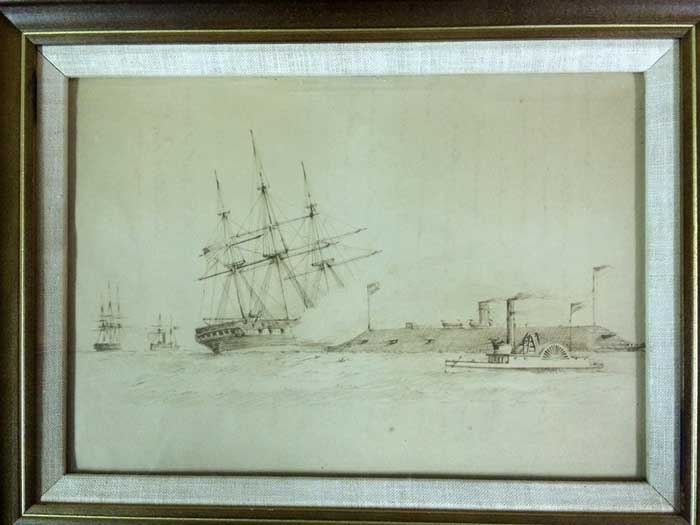
Left: Original ink drawing (circa 1862) of CSS Virginia about to ram the USS Cumberland.
From the collection of the Portsmouth Naval Museum.
Right: At the USS Monitor Foundation on tour (August 6, 2015) during a rare draining of the conservation tank.
A dent delivered from the CSS Virginia onto the USS Monitor's gun turret.Norfolk Navy Yard’s First Steam Engine
Norfolk Navy Yard’s First Steam Engine
Conversion of the USS Langley at Norfolk 1920-1922
This morning by the wonders of Facebook I was met with an excellent written article by the Public Affairs staff at the NNSY that stated in part: "On this day in Shipyard History: Norfolk Naval Shipyard commissioned the nation’s first aircraft carrier, USS Langley, on March 20, 1922. Converted from the collier Jupiter and nicknamed the "Covered Wagon," Langley transported the Navy's first carrier aviation pioneers to sea and provided a testing platform to research designs for future carriers and carrier-based aircraft."
This vessel shall forever be part of America’s Shipyard’s proud past of first accomplishments. By this conversion we created the first aircraft carrier CV-1 right here at the Norfolk Navy Yard as were called back in the day.
Research is like detective work when we go diving deeper in order to seek out where this work was specifically done. Oftentimes no one institution today holds images from beginning to end as they have been cast to the wind over the decades and have landed in multiple locations, if they have survived at all. I would like to offer two bookend images to nicely compliment the circa 1921 mid-conversion image at Berth 7&8 that NNSY posted today on Facebook.
What might not be known is the early conversion work of the ex-Jupiter takes place in our Dry Dock #3. Confirmed by a rare image (from the Historic Norfolk Navy Yard Glass Plate Collection, #2649 taken on 6/23/1920) one can see the early progress on the soon to become USS Langley.
Why do we exist? The answer is to fix ships and send them back into their element, the sea. As viewed in this also rare image courtesy of the Portsmouth Naval Shipyard Museum, Portsmouth Virginia the newly christened USS Langley is now at sea about to receive a plane, circa 1922.
We accomplished the conversion of the Navy’s first aircraft carrier here with the USS Langley CV-1. We will in due time repair and provide upkeep on the Navy’s newest aircraft carrier the USS Bush, CVN-78. At Norfolk, aircraft carriers have been our business for almost 100 years because – "history matters."
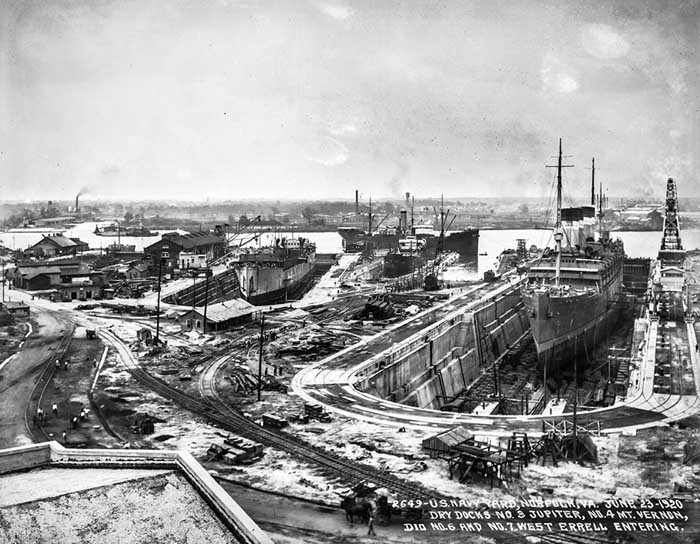
Left: Historic Norfolk Navy Yard Glass Plate Collection, #2649 taken on June 23, 1920.
Just off center left is the ex-Jupiter in Dry Dock #3 very, very early in the conversion.
Right: USS Langley soon after leaving Norfolk Navy Yard, circa 1922.
Photo courtesy of Portsmouth Naval Shipyard Museum, Virginia1st Women Welder Class at NNY ~ 9/2/1942
This past Friday on March 25, 2016, I was offered the honor to be the featured speaker for the Federal Woman’s Program (FWP) at the Norfolk Naval Shipyard. I spoke on "The History of WOMEN in the Shipyard" and covered over 100 years of their contributions at our location.
I chose to provide a pictorial look back rather than a written one and to say the research was a challenge would be an understatement. None the less, it was plain fun finding about 100 back-in-the-day real 8"x10" photos or even images of photos featured in our regular newspaper that has been published here under various names and in different formats from 1942 to date. Some of these earlier names will not be familiar but first came DEFENDER, then SPEED VICTORY and finally, SERVICE TO THE FLEET.
Featured on page 4 of the September 2, 1942 edition of DEFENDER is a photo of the first 38 Women Welder Trainees of the Norfolk Navy Yard (NNY) assembled near the Welding School at Building 261. World War II was now in full swing here and welding was a trade that women were well suited to learn and make a meaningful contribution. At the height of World War II it is said there were 5,000 women working here side by side in the total swell of 43,000 employees at this location.
As I stated during my talk last Friday, I called attention for the audience to recognize that also in the newspaper image was Rear Admiral Gygax, Commandant of the Shipyard. He appears all over the yard in the newspaper stories of those times. When the workers see their ultimate leader on the deck plates, I have always stated that without words it validates the importance of their job. He must have been a remarkable man under such great pressure, a true leader.
As I was culling photos to use for my presentation, I also found one of my favorite images, a woman Welder at the Assembly Shed portion of Building 261 who is welding upon a structure. Her face shield has a big set of lips on it, a classic image circa 1943.
In conclusion, as I write this I think back upon my own career as a Welder trained on this same Navy Yard’s waterfront also in Building 261 where the Burning School was then located in the late 1970’s. As I recall now, that smaller metal structure inside of the west end of the large Assembly Shed of Building 261 was very old back then. It would not surprise me if I did not learn part of my trade upon the very same footprint that was then used as the same Welding School where these women whom are pictured in the 1940’s learned their craft because – "history matters."
1. September 2, 1942 edition of DEFENDER, Norfolk Navy Yard's weekly newspaper at the time.
First class of Women Welder Trainees at Building 261.
2. Woman Welder, at Building 261 Assembly Shed, circa 1943.M-22 Construction 100 Years Ago Today
When you can find an image that was taken exactly 100 years ago, it is a "wow" moment of sorts. Please enjoy this rare image (from the Historic Norfolk Navy Yard Glass Plate Collection, #1090 taken on 4/1/1916).
As I was trolling for a thought to be inspired on tonight, I just happened upon this particular image of the crane being set before construction on what we know today as Building M-22. This might be a building that has been part of your daily NNSY skyline view or perhaps your current or former place of work.
Building M-22 was constructed in the 1916-1919 timeframe to house 250 Marines. The Marine Officers School for Service Afloat, the only one of its kind in existence, began in 1918 to teach young officers seamanship, ordnance, naval law, navy and shipboard organization, hydrography and history.
Also I include a color image from my own personal collection of M-22 on July 2, 1926 that shows the pine tree grove. The last of these very mature trees were removed when the parking lot was expanded a few short years ago.
Building M-22 has served our country and supported Marines during World War I & II, Korea and Vietnam. In 1957 Marine Barracks, Norfolk, Virginia, consisted of 30 acres and 22 buildings. One of the more colorful and popular was found right next door, Building M-23 otherwise known as the little Tun Tavern. Most of our current employees knew this location as the old McDonald's eatery that was demolished in 2011.
The Marine Corps color detail lowered the flag in front of building M-32 for the last time on 30, September 1978. Building M-22 Marine Corp’s barracks and training support also came to a close that day. Building M-22 continues to serve Norfolk Naval Shipyard and its tenant activities in administrative roles at present. It remains very proud of its Marine Corps past because – "history matters."
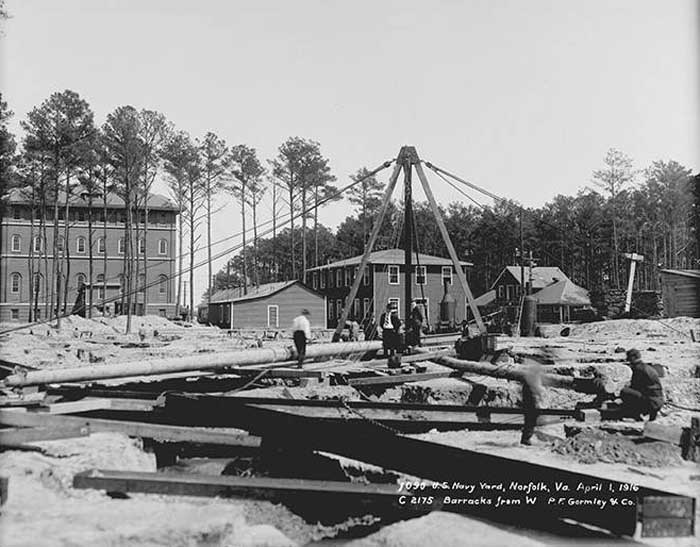
Left: M-22 setting up the construction crane (from the Historic Norfolk Navy Yard Glass Plate Collection, #1090 taken on 4/1/1916)
Right: M-22 on July 2, 1926. Photo from the personal collection of Marcus W. Robbins.Gosport, Before the Powder Exploded – 155 Years Ago
Today I lay the foundation of several future "History Matters ~ Visions of the Past" postings over time that shall use parts of or, in this case, whole stories I previously published. As we begin to look back at 155 years ago with the start of the Civil War it is vital to learn how our Shipyard played a direct role in shaping its outcome.
I wrote my long form "History Matters" Blogs #4-20 for over 13 months (2011-2012) that covered the conditions here before the 2nd burn by the Union, the conversion of the CSS Virginia, The Battle of Hampton Roads, the 3rd burn by the Confederates and finally the re-raising of the Union flag to celebrate the 150th anniversary of those specific events.
Concurrently four of my personal artifacts were featured in the local newspaper, The Virginian Pilot, as they had a large 6 week feature "Voices of the Civil War" to where they made an appeal for local stories and artifacts. The series is still available in booklet form. This indeed is my favorite time period so enjoy the look back at our shipyard. A lot of our north end facilities remain today and you can see evidence on each of their own individual battle scars if you know where to look. My prior "History Matters" Blog #4 describes these facilities in detail below.
In 1861 the Gosport Navy Yard (GNY) was the premier Naval Station for Uncle Sam here along the banks of the Elizabeth River, but in March of 1861 the winds blew with an uneasiness that the below images cannot capture. Ultimately on April 21, 1861, things were about to drastically change the very landscape we work at today.
On February 18th, Jefferson Davis was inaugurated at Montgomery, Alabama, as President of the Confederate States of America. On March 4th, 1861, Abraham Lincoln was inaugurated as President of the United States. The atmosphere hung heavy with the dark clouds of a civil war coming on. Newsprint of the time was full of speculation of Mr. Lincoln’s recent call for arming of troops, likewise the South began to establish a formal military structure, sides were being drawn and soon talk of secession was in the air throughout the South. With the April 12, 1861, action at Fort Sumter in South Carolina, the die was cast for the ultimate direction that Virginia would take, succeeding from the Union on April 17th, 1861.
But now back to life at GNY before the late unpleasantness –
I want to paint a mental image for you what Gosport was like and will cover our canvas with a collection of statements contained in 36th Congress, 1st Session, House of Representatives, Document Number 34 of March 2, 1860, that was really an investigation report on all the Navy Yard conditions at the time. Also, with a look back using 37th Congress, Senate, Document Number 37 of April 18, 1862, that provides colorful background before the destruction of Gosport; this document frames an accurate written account of the physical shipyard appearance and shipbuilding infrastructure leading up to the raging inferno yet to come.
Upon the date of the visit of June 20, 1859, in the first mentioned document, the following lead statement was made that reads in part "It is the largest and most important yard in the United States"… Later within this document is found "The general appearance of the yard is good, and the building in pretty good order, with the exception of the ship-houses". Writer’s note – the large ship-house structures you see in the below engraving were erected in 1820 over top of the stone building ways, so being constructed entirely of wood and with dirt floors forty years later they must have been a sight to see. It is at this location, just north of the iconic Hammerhead Crane today we have a large parking lot, so just under our feet remain the granite ruins of both ship-houses "A" & "B".
Found within the Senate Review a detailed narrative of Gosport is given. "This yard was one of the oldest naval depots in the country, and since its original establishment had been very much enlarged in area. At the time of its abandonment, on 20th of April, 1861, it was about three-fourths of a mile long and one-fourth of a mile wide, being by far the most extensive and valuable yard in the possession of the United States. There was connected with it a dry dock of granite like the Charlestown dry dock. The yard was covered with machine shops, dwelling-houses for officers, and storehouses of various kinds. There were in it two ship-houses entire and another in progress of erection, marine barracks, sail loft, riggers’ loft, gunners’ loft, numerous smith shops and sheds, carpenters’ shops and sheds, machine shops, timber sheds, foundries, dispensary, saw-mill, boiler shop, burnetizing-house, spar-house, provision-house, numerous dwellings, and a large amount of tools and machinery. There were also great quantities of material, provisions, and ammunition of every description".
All of this was about to change, Gosport Navy Yard would never be the same because – "history matters".
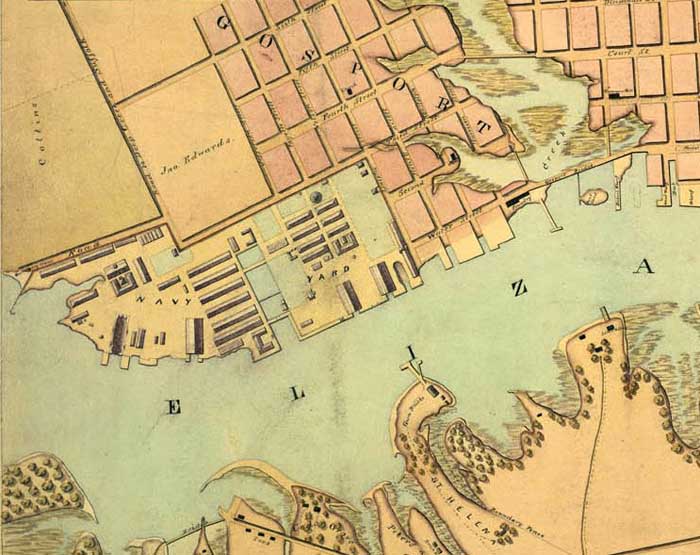
Left: (Partial Section) Plan of the Harbor of Norfolk and Portsmouth
by Chas. E. Cassell, March 1, 1861.
(Courtesy of Sargeant Memorial Room)
Right: The Navy Yard at Norfolk, Virginia
Harpers Weekly, Page 164 of March 16, 1861
(Courtesy of Marcus W. Robbins)The History of Rear Admiral Daniel J. Callaghan & Building 310
On April, 15, 2016, the NNSY Morale Welfare and Recreation (MWR) management and staff celebrated a grand reopening after major improvements to their world class facilities. Also, they came to me a few weeks ago to assemble the history of the man for whom the building is named. The following is my submitted research that was read prior to the ribbon cutting today. Rear Admiral J. Callaghan was a true American hero. I learned so much and shall forever have a new found respect for our Navy servicemen whom gave their lives in World War II.
As described on the front page of a rare document, "The Serviceman’s Defender" from Norfolk Navy Yard, November 30, 1943, volume 1, number 20, we find the following banner headline.
TWO RECREATION CENTERS IN YARD HONOR MEMORY OF HEROSRear Admiral Daniel J. Callaghan, USN and Rear Admiral Norman Scott, USN were both killed on the same day, November 13, 1942, during the Battle of Guadalcanal.
Building 310 previously unnamed, is one of those recreation centers and was completed on July 1, 1941. As the anchor point of the former Barracks "B" complex that once stood on these grounds Building 310 provided 40,000 square feet of modern recreation facilities to take care of the health of the Navy’s men and women ashore as World War II was just over the horizon.
Rear Admiral Callaghan was born in San Francisco, California on July 26, 1890.
After completion of high school, he was appointed to the Naval Academy. He graduated in the Class of 1911 as a Passed Midshipman.
On May 7, 1912, he was commissioned Ensign and served on the battleship USS CALIFORNIA from 1912 to 1913.
On June 30, 1913, he was transferred from CALIFORNIA to the destroyer USS TRUXTON. On March 22, 1916, he assumed command of the TRUXTON.
In November 1916 he then joined the protected cruiser USS NEW ORLEANS. During World War I aboard this ship he first served as her Engineering Officer and later as her Executive Officer.
After duty in the Bureau of Navigation from late 1918 until October 1920, he served three years as the assistant Fire Control Officer of the battleship USS IDAHO.
His next duty was with the Board of Inspection and Survey till the spring of 1925, when he joined the battleship USS COLORADO and served as her First Lieutenant until he was transferred to the battleship USS MISSISSIPPI on April 6, 1926, for two years as her Engineering Officer.
From August of 1928 till February 1937 Callaghan served numerous shore duty assignments each centered on gunnery and fleet training.
From February 7, 1936, till June 7, 1937, he served as Executive Officer aboard the cruiser USS PORTLAND.
He was appointed Naval Aide to the President on July 14, 1938, and served in that capacity until May of 1941.
On May 2, 1942, upon transfer to Headquarters, South Pacific Fleet, he served as Chief of Staff and Aide to Commander of that Force. On June 19, 1942, he assumed command of Task Force, Pacific Fleet.
He was nominated for promotion to the grade of Rear Admiral on June 19, 1942. This rank increase was confirmed by the United Stated Senate on June 22, 1942.
Rear Admiral Callaghan was killed in action during an engagement with the Japanese fleet in the Solomon Islands on November 13, 1942.
On December 9, 1942, President Roosevelt awarded the Medal of Honor posthumously to Rear Admiral Callaghan and presented it to his son. The citation follows:"For extraordinary heroism and conspicuous intrepidity above and beyond the call of duty during action against enemy Japanese forces during the Battle of Guadalcanal on the night of November 12-13, 1942. Although out-balanced in strength and numbers by a desperate and determined enemy, rear Admiral Callaghan, with ingenious tactical skill and superb coordination of the units under his command led his forces into battle against tremendous odds, thereby contributing decisively to the rout of a powerful invasion fleet and to the consequent frustration of a formidable Japanese offensive. While faithfully directing close-range operations in the face of furious bombardment by superior enemy fire-power, he was killed on the bridge of his flagship. His courageous initiative, inspiring leadership and judicious foresight in a crisis of grave responsibility were in keeping with the finest traditions of the United States Naval Service. He gallantly gave up his life in the defense of his country."
Please take time to observe and read the bronze plaque above the front doors of Building 310 and take pause for a moment of the ultimate sacrifice this gentleman gave for his country because – "history matters".
On April, 15, 2016 the NNSY Moral Welfare and Recreation (MWR) management and staff
celebrated a grand reopening after major improvements to their world class facilities.
The 2nd Burn of the Navy Yard 155 Years Ago Today
History Matters Blog 8Today (April 21, 2016) marks the 155th anniversary of the Union setting fire to the Norfolk Navy Yard and attempting to destroy eleven vessels in the stream or at the wharfs. The flare signal was given at twenty minutes past four in the morning as the evening of April 20th preparations for destruction were made complete. Essentially the nation’s most complete naval shipyard was passed to the Confederates without a single shot being fired.
Because of the inaction of Captain McCauley by neglecting to send the Merrimac from the yard as he was ordered and to protect the yard as directed, I personally feel that he set in motion for the duration of the Civil War to last much longer than necessary. This is attested to by the great amount of cannon and shipbuilding stores that were instantly passed to the southern cause without bloodshed. A supreme industrial base of shipbuilding operations for the next thirteen months was now provided to the Confederacy. By the nightfall of April 21, 1861, the flag on the staff had been changed to the one of the State of Virginia.
The below paragraph is taken from the H. W. Burton’s 1877 book – The History of Norfolk Virginia.On Saturday night, April 20th, 1861, the Gosport Navy-yard was evacuated by the U. S. Government troops. General Taliaferro, commandant of the Virginia militia at this place, made a demand upon Commodore Macauley for a surrender of the Government property at the yard, which was refused – the Commodore assuring General T. that nothing would be removed and no vessel should leave the yard without due notice being given him. This assurance quieted our people for a while; but in short time it was observed that the hands in the yard were engaged in "cutting down the shears, (which fell across the Germantown), scuttling the vessels, spiking the guns and destroying everything they could lay hands upon."
The following provides summary as given in testimony to the select committee of the Senate appointed by resolution of the 25th of July, 1861, that was formed to inquire into the circumstances attending the destruction of the property of the United States at the Navy Yard at Norfolk.
On the 18th of April, Captain Paulding was sent to Norfolk with written instruction to take command of all the naval forces there afloat, to defend the property of the United States, repelling force by force, and, if necessary, to destroy the vessels and property there to prevent them from falling into the hands of the insurrectionists, or those would wrest them from the custody of the government.
He arrived at the navy yard at about 8 o’ clock in the evening of the 20th of April; he had at his command all the vessels of war belonging to the United States, and fully one thousand effective men, viz: one hundred marines, taken at Washington on board the "Pawnee" in which vessel he went to Norfolk, the crew of the "Pawnee" of one hundred men, Colonel Wardrop’s regiment of Massachusetts volunteers, consisting of three hundred and fifty men taken on board the "Pawnee" at Fortress Monroe, three hundred and fifty men on board the "Cumberland," and at least one hundred and fifty marines and sailors at the yard on the receiving ships.
Captain McCauley was highly censurable for neglecting to send the Merrimac from the yard as he was ordered, and also for scuttling the ships and preparing to abandon the yard before any attack was made or seriously threatened, when he should have defended it and the property instructed to him, repelling force by force, as he was instructed to do if the occasion should present itself.
In quick fashion summary as many reams of paper have been written by others before me, the following events transpired over the evening of April 20 and into the morning of April 21, 1861. Gosport would now fall victim to the match for the second time. The flag would change from the Union stars and stripes to that of the State of Virginia by daylight of the 21st, all without a single shot being fired.
Crews of men were scatted upon the yard with the sole purpose to destroy anything of value to prevent it falling into the hands of the secessionist. Machinery and supplies and the facilities protecting them were not ignored. The mighty shear (the large crane to load cannon upon vessels) located between the ship houses, "A" & "B" had been cut down and fell across the Germantown earlier in the afternoon. The ships in the stream were scuttled and began to sink in place. Guns were spiked, that is to say having rat tail files or nails driven into their touch-hole to render ineffective for a short time, unsuccessful attempts were also made to break trunnions with sledgehammers to render the vast number of cannon useless. The great granite Dry Dock was mined with enough powder to destroy everything in the southern end of the yard but the match failed somehow. Trains of powder were laid upon the decks of the ships in the stream, the mighty ship houses and certain of the buildings on the yard in order to ignite the turpentine and cotton wastes carefully placed to insure that sheets of flames would reach up into the heavens once the order was given.
At 4 o’clock in the morning all was ready and the Pawnee slipped her mooring and took out the Cumberland in tow. At twenty past four the concerted signal was given by a rocket from the Pawnee, the torch was applied simultaneously at many points and in a few minutes the ships and their buildings in the yard were wrapped in sheets of flames and explosion as ammunition from the heavy guns burst as the intensive inferno raged. The countryside was illuminated for miles around, the roar of the flames must have been unbelievable as years of work and materials were consumed, useless for neither side now.
Today, 155 years later America’s Shipyard stands proud to serve the United States Navy. If you know where to look you can see many evidences of this very fire today on our extremely well-constructed brick facilities because – "history matters."Harpers Weekly double fold engraving reading:
Destruction of United States Navy Yard at Norfolk, Virginia, by fire, by the United States Troops, on April 20, 1861.
Destruction of the United States Ships at the Norfolk Navy Yard, by Order of the Government.
(Courtesy of Marcus W. Robbins)
Completion of Shipbuilding Ways #1
Most people reading this short article never witnessed the huge steel structure that dominated the Norfolk Naval Shipyard waterfront from 1917 to 1974. It was gone a full three years before I came to work so indeed photographic images do become our visions of the past.
Following long accepted shipbuilding traditions, ships have been launched stern first from their point of construction. While the entire ship rests upon the keel as its backbone, wooden cradles are placed aside the hull and these cradles then assist the ship to slide down the greased ways when it comes time to launch into its element.
While this is not an inclusive history of Shipbuilding Ways #1, it does recognize by a rare image the final completion activities occurring this week back on April 24, 1919, to complete the ways down into the water. Also the remaining obstacles in the river are visible and not yet removed including where the German Raiders had once been interned along a river pier. World War I had been a game changer for the Norfolk Navy Yard, we again had become a building yard for Uncle Sam’s fleet.
USS Hulbert 342 & USS Noa 343 had their keels laid on November 18, 1918. Each were launched on June 28, 1919, from Shipbuilding Ways #1. Both of these ships later served our country in the Pacific during World War II. USS Hulbert received two battle stars including defense of Pearl Harbor in which she was credited with shooting down an attacking Japanese plane. USS Noa received five battle stars and was lost in the Pacific on September 12, 1944.
We go on to build many other ships on Shipbuilding Ways # 1 and also its smaller neighbor to the north known as the Destroyer Ways. Upon these two sites many of our war time vessels are constructed as Norfolk helped win World War II with the construction of 101 total vessels from 1939-1945.
With the launching image one can see witness USS Hulbert sliding into the water on the ways that was completed just two months before. When one compares both images side by side you have a real back in the day feel of the same location, yet now long gone because – "history matters."
Left: Shipbuilding Ways Looking East
(Historic Norfolk Navy Yard Glass Plate Collection, #2204 taken on 4/24/1919)
Right: Launch of USS Hulbert 342 & USS Noa 343 on June 28, 1919
(Historic Norfolk Navy Yard Glass Plate Collection, #2273 taken on 6/28/1919Opening of Dry Dock #4 – 97 Years Ago Today
Drydock 4 at the Norfolk Navy Yard was at one time the largest concrete structure in the world. With a usable length of 1,110’-10" and a floor thickness of 20’ it can be summarized in one word – "massive".
As a structure it is begun on 8 January 1917 and is declared completed on 1 April 1919. It along with so many other Norfolk Navy Yard facilities upgrades and expansions of the time is a direct result of World War I.
The 1st ship to enter the Navy’s largest dock to that time is the USS Wisconsin as shown in the first photo, 97 years ago today on May 5, 1919. Dry Dock #4 has been in continual service to the fleet from this time, servicing all types of naval vessels.
Any place can have a river berth or a pier to safely tie a vessel up to, but what sets apart a true shipyard is its ability to perform dry docking. This location, being the Norfolk Navy Yard along the Elizabeth River has the ability to take any vessel of Uncle Sam’s Navy out of its natural element (water) and allow it to become docked (dry) so craftsmen may preform repairs.
This second photo of the USS Wisconsin’s stern sitting up upon the blocks is also a fitting way to see a glimpse of the World War I facilities expansion as the new modern Power Plant, Building 174, has also just been completed as viewed in the background. But for a moment focus upon the facility of Dry Dock #4 itself: I conclude with the same word I started with –"massive".
Dry Dock #4 has provided the United States Navy with over 97 years of continuous service here at "America’s Shipyard" because –"history matters".
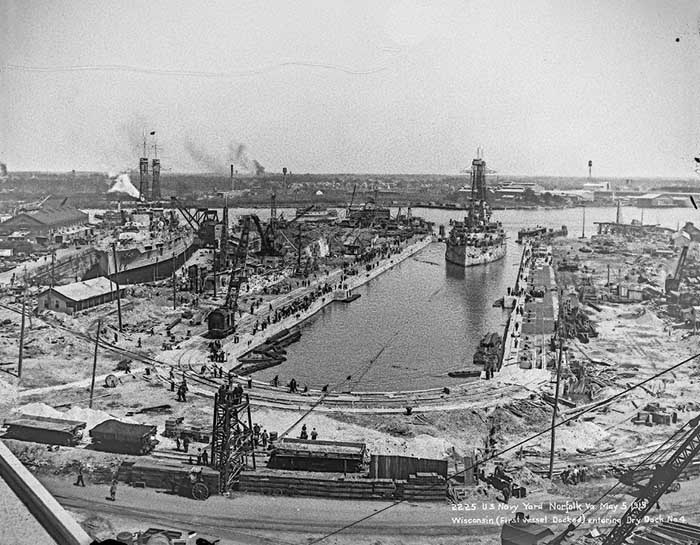
Left: USS Wisconsin (Historic Norfolk Navy Yard Glass Plate Collection, #2225 taken on 5/5/1919)
Right: USS Wisconsin (Historic Norfolk Navy Yard Glass Plate Collection, #2227 taken on 5/5/1919)Before the Southern & Westward Expansion – 108 Years Ago
Rare maps, period photographs and the written word are the best friends to an Historian & Archivist. Without these items how can one appreciate where we have come from as a shipyard?
For those that know me realize that I have been involved with the facilities and the grounds of the Norfolk Naval Shipyard my entire career. Right out of Norview High School I entered as a Welder Apprentice on October 20, 1977, then after 7 years on the waterfront I was promoted to Public Works Planner, then over the years I obtained promotions to Facilities Contract Specification Writer, and finally my last assignment with NAVFAC was serving as a Facilities Maintenance Specialist. Prior to retiring, my last 5 years before August 1, 201, were the result of one final promotion into NAVSEA as the Code 1100 Executive Support Command Facilities Manager. Much has changed from that time of just shy of 39 years to now as I work on our archives and artifacts in a less stressful role to document and preserve our great story.
Again, as with any job, you have to know where you fit in to the big picture of the guiding principles of the shipyard. Employee education falls squarely into "Brilliant on the Basics" and in my view that is why I write these columns for our workforce or that I give presentations to various audiences, that they may first personally learn about their workplace. On top of that if they can come away with an intrinsic pride of this station’s heritage of service to the United States Navy, hopefully they too may see their connection in becoming part of our continuing history every day.
As I always say, "you can’t know where you are going if you don’t know where you have been".
108 years ago this week a series of glass plate photos were taken from the roof of the then Power Plant, Building 60. A commanding view it was and I am featuring just one, the southern and westward image, that shows a much different physical environment. Often I have stated that this Navy Yard could not be constructed today because of all of the dredge and fill, but over 100 years ago was a different time with different rules or lack thereof. Judge for yourself as you view the glass plate and pick out some facilities still with us because they have stood the test of time.
Norfolk has always been about mission. Because this location continued to be of utmost importance to the nation after the Spanish American War, along with being ripe for the instant expansion that World War I would bring within the next decade, the Norfolk waterfront and physical plant had to grow. You all that have worked along our waterfront need to reflect on just how much we have grown over the last 108 years.
As far back as the late 1860’s, several plans for both improvement of the plant and expansion of facilities were proposed within the boundaries of the brick wall but for the most part never enacted. By the 1880’s, land surveys were completed to the south of the wall otherwise the area beyond present day Dry Dock #3. This area was known as the Schmoele Tract and consisted of just over 272 acres.
Found within The History of Our Navy Yard by Com. A. W. Ashbrook, Aid to the Commandant, Navy Yard, Portsmouth, Va. in 1927, we find the following statement:
"In 1907 the authorities, realizing that the Yard must expand in order to carry on its important work, purchased the large tract of land to the southward known as the "Schmoele Tract" upon which now stand the Marine Barracks and the large modern shops."
I do wish to thank an acquaintance of mine, Mr. Jefferson M. Moak, now a former Archivist, National Archives, Philadelphia, Pa., for providing me some years ago a transcription of this rare document.
Anyway, in closing, please compare the November 1902 survey of the Schmoele Tract side by side with the May 13, 1908, glass plate image. Marvel at the wonders that the Navy Yard Civil Engineers in our Public Works Department were able to craft out of this waterfront wasteland over the last 108 years and turn it into the nation’s most complete naval repair yard because –"history matters".
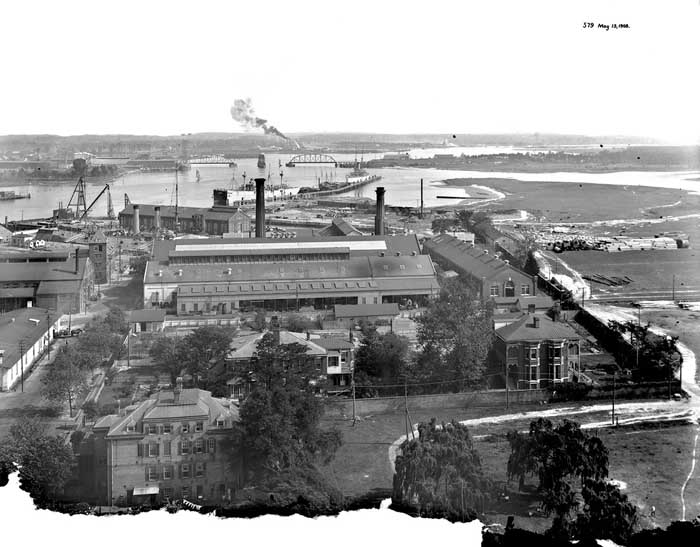
Left: Looking South and West from Building 60 Roof. (Historic Norfolk Navy Yard Glass Plate Collection, #0579 taken on 5/13/1908)
Right: Schmoele Tract. (Map of Government to Condemn Lands, 272 Acres, November 1902). Image Courtesy of Portsmouth Naval Shipyard MuseumThe Schmoele Tract - 113 Years Ago
I started out my last writing with the following lead sentence as it remains so relative: "Rare maps, period photographs and the written word are the best friends to an Historian & Archivist. Without these items how can one appreciate where we have come from as a shipyard?"
I received such positive feedback from my last posting that showed the southern and western view of our busy shipyard with a 1908 photo and the undeveloped Schmoele Tract of land beyond the brick wall, so please consider this a "Schmoele Tract Part II" of sorts, but even further back to the year of 1903. As I have stated many times before, period photographs and maps are indeed our special window - our own "visions of the past."
Now I present three undated glass plates that I can attest to are taken in the year of 1903. These photos are taken from perhaps the roof of Building 72 (site of present day Building 1505) and are indeed super rare. Together these three form a sweeping view from the south of our present Dry Dock #8 area arcing around due west to include the present day waterfront and industrial core and including the land of the ex-Marine Corps buildings (that are not yet constructed) and finally viewing to the northwest near the present day Gate 10. The community of Newtown is also seen in the distance beyond today’s Portsmouth Boulevard. Note it has a Russian name of Cossack Street, but that is for another future story tied to this Navy Yard’s rich heritage.
Yes, those are cattle grazing at America’s Shipyard 113 years ago. Much has changed over the last century, it is indeed important to know where you came from because –"history matters".
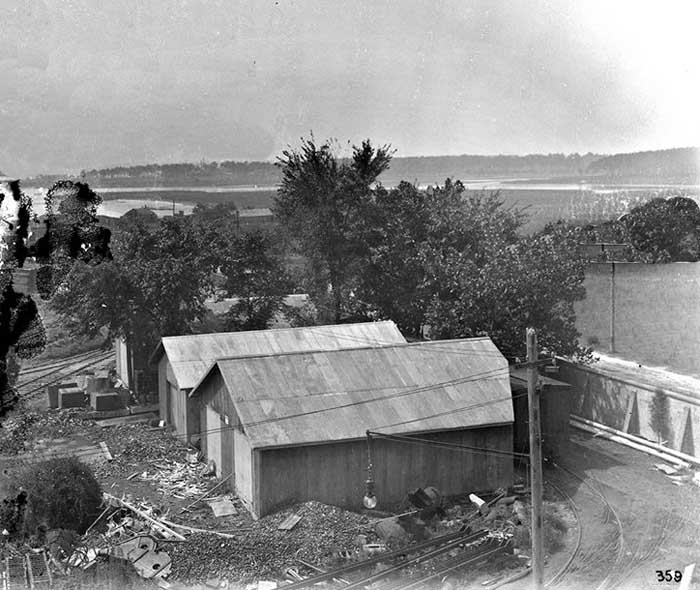
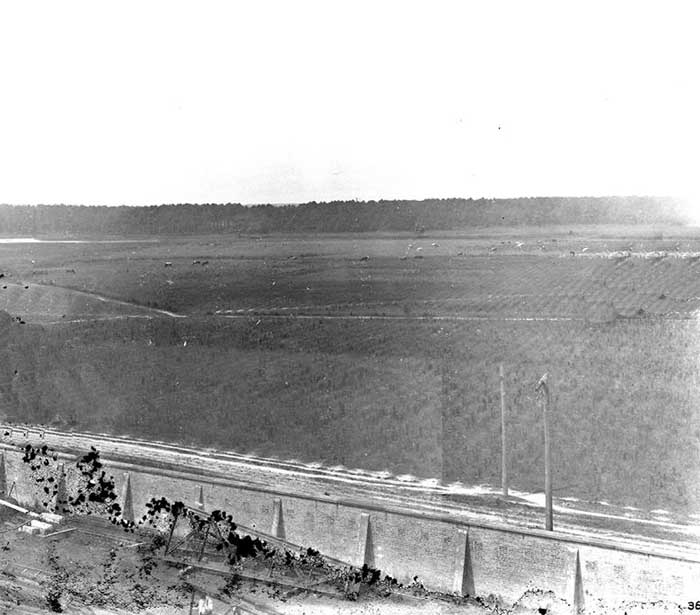
Left: Schmoele Tract beyond the brick wall and Cement Storage Shed, Building 77 in the foreground.
(Historic Norfolk Navy Yard Glass Plate Collection, #0359 taken in 1903)
Middle: Schmoele Tract beyond brick wall looking due west, present day Marine buildings not yet constructed.
Note the cattle grazing in the field. (Historic Norfolk Navy Yard Glass Plate Collection, #0360 taken in 1903)
Right: Schmoele Tract beyond brick wall looking northwest, Newtown in distance (beyond present day Portsmouth Boulevard.
(Historic Norfolk Navy Yard Glass Plate Collection, #0361 taken in 1903)The Building Ways - 98 Years Ago
My prior Visions of the Past #20 featured the first two destroyers launched on our ship Building Ways, the USS Hulbert 342 and the USS Noa 343 on June 28, 1919. If you notice on the photo, they are slipping into the water via a trench cut at the shoreline. The challenge I have sometimes in telling our rich story is that there are no modern landmarks for the reader, especially if they are younger and or even if they work here, to relate to upon what ground a facility may have been located.
I selected the full southern elevation of the Building Ways that was taken this day, May 22, 1918, just a mere 98 years ago to illustrate the size of this enormous structure. The Schmoele Tract of land was just being developed as the country found itself in The Great War and the Norfolk Navy Yard was about to explode with non-stop facilities construction. In the foreground of this photo, what we know as Pier 3 has not yet been constructed as it is just marshland, neither had the Wet Slip #3 been dug out or even Pier 4 been thought of. The shipyard was about to begin expanding southward and fast.
In comparison to location of the Building Ways, note from my personal collection a rare commercially produced post card of USS Nimitz at Pier 3, circa October 1975. Much of the appearance has changed at America’s Shipyard but the trench cut into the water of the Building Ways is plainly visible just to the north of Pier 3 as the Building Ways were demolished in 1974. This post card indeed ties in all three of the photos, now you can point and say, "it happened here."
This post card view is also full of facilities that are no longer in existence, such as 4 lanes of traffic on Hitchcock Street plus inside parking, the old dock and hammerhead cranes on the piers, Building 261 as the World War II Assembly Shed and many other minor details one can locate. Pier 3 has finally been modernized this last decade, but Pier 4 and Pier 5 as shown have been demolished to make way for the new super Pier 5A. Finally, back on topic of the Building Ways, this site was eventually filled in and leveled to support a new river berth as the Pier 3 crane rail was extended along the new river berth. Also there has been and currently continues much new construction around Building 261 to support a 21st century nuclear support shipyard.
Facilities may change but the mission remains the same, "we fix ships". Still yet, it is important to know we can’t fix ships without facilities because –"history matters".
Top Left: Building Ways, southern profile, looking northward before the Pier 3 construction in foreground.
(Historic Norfolk Navy Yard Glass Plate Collection, #1692 taken on 5/22/1918)
Top Right: Launch of USS Hulbert 342 & USS Noa 343 on June 28, 1919.
(Historic Norfolk Navy Yard Glass Plate Collection, #2273 taken on 6/28/1919
Bottom: Post Card View of USS Nimitz at Pier 3 (circa October 1975) Note, one leg of the original 1918 Building Ways remained
as a tower for years (into the late 1990's) as seen next to the water. (Courtesy of Marcus W. Robbins collection)The Machine Shop & Foundry Rise Up - 99 Years Ago
Ask any old time Yardbird about Buildings 171 or 172 and instantly they might say, "…those were first built as our Machine Shop and our Foundry". As evidenced with their facility assignment numbers (171 & 172) and also the fact with their physical locations are right next to each other, they have forever been associated with each other. So, it will be fun to reflect back on what the overall site looked like on June 1, 1917 - 99 years ago as I write this.
I hold in my hands a copy of a rare Public Works map #4707 titled: PROPOSED FINAL LAYOUT FOR DEVELOPMENT – United States Navy Yard Norfolk, Va. dated December 28, 1917. It contains a note that the old yard was as of that date 88.339 acres in size and the Schmoele Tract was 273.192 acres. This document becomes the facility vision and the blueprint for our shipyard’s growth. Now some of the future plans as presented did not happen such as Dry Dock #5 but mostly all of the central waterfront facilities of the Norfolk Naval Shipyard today can use this map as a birth certificate of sorts, it even contains survey points for the corners of those buildings as they stand today.
I have always said that this shipyard could not be constructed today because of all the cut and fill required since the waters of Back Creek extended all the way to west of today’s Building 510. It was a different time back then without such strict environmental controls, so the entire footprint had to be used in the best manner possible. More importantly, the United States had already declared war on the German Empire, thus we had entered into The Great War on April 6, 1917, so an expanded industrial base was essential to fix ships.
While machine shop and foundry functions have always existed here in buildings at the old northend of our shipyard from the 1800’s, the growth of the shipyard has always been to the south so larger more modern facilities would be required. With so much existing open high land included within the Schmoele Tract, the time had come for Buildings 171 & 172 to be born.
I conclude with discovering that contracts (2371 & 2375) were issued to the George E. Wyne Company to construct both 171 & 172. A photo of their survey team is included. Also I provide the very first documented surviving images of each building. There were others, I am sure, but they are lost to time. In future editions of my "History Matters ~ Visions of the Past," we shall explore the progress of these and other major facilities that Uncle Sam erects in a matter of two short years to help win the war on the home front at the Norfolk Navy Yard because – "history matters".
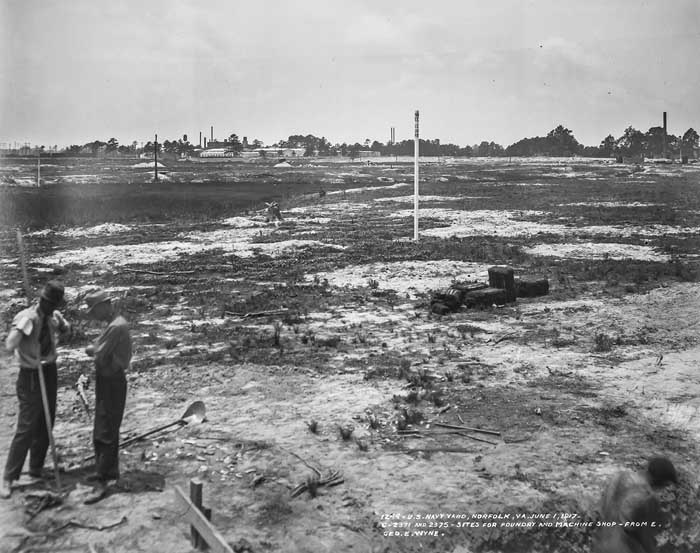
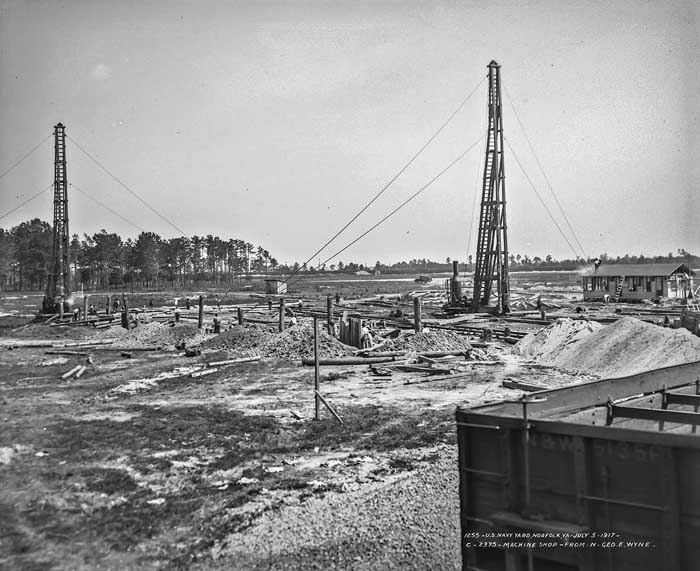
Left: Site for Machine Shop & Foundry (looking from east) Also in the view, ex-Dean Hard Woods site which is our gavel military parking lot
of today beyond in far distance). (Historic Norfolk Navy Yard Glass Plate Collection, #1244 taken on 6/1/1917)
Middle: Machine Shop, Building 171 (looking from north). (Historic Norfolk Navy Yard Glass Plate Collection, #1255 taken on 7/5/1917)
Right: Foundry, Building 172 (looking from southwest).
(Historic Norfolk Navy Yard Glass Plate Collection, #1290 taken on 8/30/1917)The Structural Shop Takes Shape – 99 Years Ago
In a continuation of my last "History Matters ~ Visions of the Past," the Norfolk Navy Yard’s vast industrial complex continued to grow upon the newly gained Schmoele Tract of land. Upon this highland and riverfront swamp are constructed both piers and massive shop buildings. One of the most important and easily recognizable is our Structural Shop, otherwise known as Building 163.
Also, as I mentioned previously in the last writing, the country had entered into The Great War on April 6, 1917, so an expanded industrial base was essential to fix ships. While in the spring of 1917 there was no way to predict how long this war might go on, it was important to begin a robust facilities improvement program to support the United States Navy. Norfolk had the land and was up to the challenge then as well as today. Our present site of almost 250 years on the Southern Branch of the Elizabeth River grew over time to the south. World War I changed everything including creation of the core industrial buildings including the Structural Shop. Where we work at today was planned a century ago.
Contract #2264 was issued to the George E. Wyne Company to construct Building 163, as was the case they also constructed both Buildings 171 & 172. So now you know why they all look similar. I have always said the Navy Yard was green before energy savings became today’s fad. Look at the huge natural day light east facing window walls, the raised monitor rooflines with high functioning louvered windows that create a negative pressure by drafting air naturally from the large rolling curtain doors. These distinctive up and down rooflines also supported natural day lighting onto the shop floor before there were inside lights.
The Structural Shop’s location of sitting parallel and directly adjacent to the waterfront piers that are yet to be constructed from a prior cattle pasture is nothing short of an engineering marvel. The Bureau of Yard & Docks, the local Public Works Department and countless others worked to make this happen. As I inventory period linen maps, hold one of the survey instruments that layed out this shipyard and view some of the actual glass plate camera devices that we have in our archives that recorded these events, there becomes a strong connection to our proud past and heritage. This shipyard was built by the efforts of many diverse individuals whose names are now lost to time but they left a tangible and lasting legacy including the Structural Shop.
In conclusion, please enjoy this rare and unique view of Building 163 as it begins its framing process. It is still a long way from being complete in regard to its final 1919 configuration (which I shall write more on), but everything has to have a beginning. For the Structural Shop the spring of 1917 marks its birth because – "history matters".
Structural Shop, Building 163 (looking from south).
(Historic Norfolk Navy Yard Glass Plate Collection, #1242 taken on 6/1/1917)
You Are Here – 99 Years Ago
Images matter. Without the ability to look back and confirm your past it becomes lost to time. My friends, I am honored to be able to interpret rare photographs to tell our magnificent facilities history.
The Schmoele Tract of land is transformed from low riverfront marsh and cow pasture into the modern core of today’s Controlled Industrial Area or as the locals call it, the (CIA). Again rare images tell our story, they are todays "you are here" directional signs in order to look back and to have your "own vision of the past."
I created the name branding for our glass plates that you see in each of my postings to be tagged as "Historic Norfolk Navy Yard Glass Plate Collection, #xxxx taken on xx/xx/19xx" some while back as a positive way to identify and document our heritage as consistency is important for the historical record.
So very much was happening a century ago and for the past few weeks and into the next few months I am going to be concentrating on the major facilities build-up supporting the Great War (World War I) and the impact it had on the Norfolk Navy Yard. As I have stated before the rare Public Works map #4707 titled: PROPOSED FINAL LAYOUT FOR DEVELOPMENT – United States Navy Yard Norfolk, Va. dated December 28, 1917, is a birth certificate of sorts. Our major Production Department facilities are now entering into their second century of service.
You also might ask, what does all that have to do with today’s modern nuclear Shipyard worker? Well, everything has to have a beginning and the images I will be sharing today look upon the very area that sets this shipyard apart as a world class repair and refueling yard. Today’s worker’s need to have an understanding of what came before them so what better tool do we have but our own internally taken glass plate photographs?
Looking from the east (with the river to their back) on May 1, 1917 there were two glass plate images taken that show a survey tent on what would by 1920 become the quay wall we know today as Pier 3, and the other image shows to its left the area that would become the Shipbuilding Ways and the USS Craven keel upon the Destroyer Ways with their special support cranes on its right. These two images form a panoramic image of sorts to define the Pier 3 to Dry Dock #4 south area, thus they document where a century later our nuclear shipyard workers spend so much time.
Another interesting fact that should not be lost is that in each image you can see some of the earliest structural steel framing of what later becomes the Structural Shop, Building 163. On May 1, 1917, our Navy Yard Photographers helped document the "you are here" sign for us a century later because – "history matters".
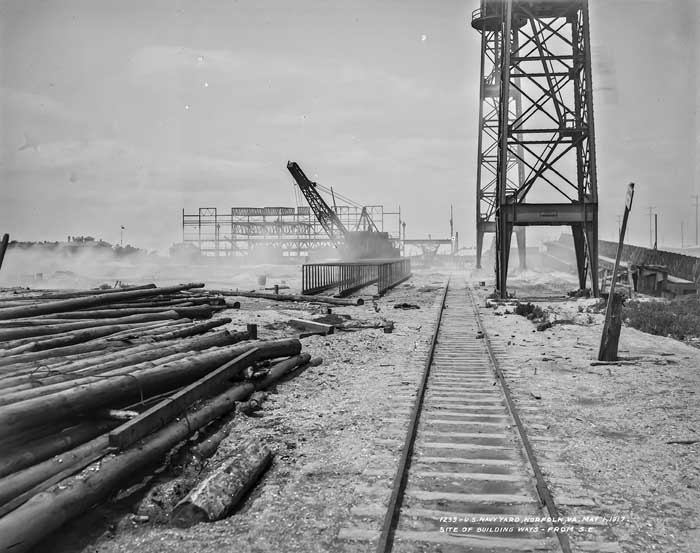
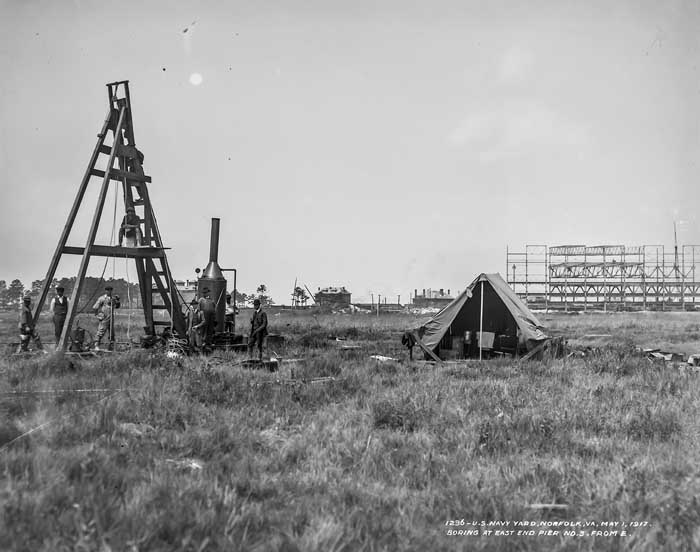
Left: Boring at East End Pier 3 (looking from east).
(Historic Norfolk Navy Yard Glass Plate Collection, #1236 taken on May 1, 1917)
Right: Site of Building Ways (looking from southeast).
(Historic Norfolk Navy Yard Glass Plate Collection, #1235 taken on May 1,1917)The Stone Dock & The USS Delaware – 183 Years Ago
Much has been written about Norfolk Naval Shipyard’s Dry Dock #1 but today on June 17, 2016, we should take pause to remember that, upon this site 183 years ago, naval history was made in the then young country of America. We successfully accomplished the very first drydocking of a vessel in the Northern Hemisphere right here in Portsmouth, Virginia, on the shore of the Southern Branch of the Elizabeth River.
A little history: Why did we need a Dry Dock and exactly what does it do?
One must be aware that the concept of modern drydocking was indeed recognized by the Americans, as our young Navy was born and grew, as a means to efficiently effect under the waterline repairs to vessels, yet the concept of placing a ship out of water and into a "drydock" goes back to early Greco-Roman practices in the area of Egypt nearly 2,200 years ago. Over the last few centuries the Europeans refined it to the practice we know today.
As with any Government program or new idea, several revisions and attempts to fund seem to be the normal course. With the construction of a drydock to support the newly formed American Navy Department, this was no different. I offer a summary here of dates and order of events found in "History of the United States Navy Yard at Gosport Virginia," (Lull 1874) which is now lost to time and never published in any other contemporary writings but important when considering the whole. Several times from the inception of the Navy Department in 1798 appropriations had been made to Congress for the construction of docks, (on the 25th of February 1799, and on the 3rd of March 1813), but the amounts appropriated were so small as to be entirely inadequate to the purpose.
On the 25th of May 1824, the Senate of the United States passed a resolution calling upon the Secretary of the Navy for information on the following points:
1st. The expediency, usefulness, economy, and necessity of a drydock of sufficient capacity for receiving, examining, and repairing ships of the line.
2nd. The best location for a drydock.
3rd. The probable expense of the construction of one of the size mentioned, in a solid and durable manner, with the needful appendages for an advantageous use of it.
The Honorable Mr. Southard, then Secretary of the Navy, in his answer to the resolution, under the date of January 3, 1825, urged in very strong terms the necessity not only of one, but of at least two drydocks for the Navy, at its then present size. He stated that the only method of examining and repairing the hulls of heavy ships below the waterline, then available, was that of heaving down, an exceedingly slow, expensive, laborious, and dangerous operation, and very unsatisfactory in its results; while, with a drydock, work might be performed in a few hours, and at trifling expense, which would take weeks by the process then in use.
Our Drydock 1 can be attributed to the one of the young country’s finest civil engineers at the time, Colonel Loammi Baldwin, Jr. Baldwin in his personal profession had made two different trips to Europe studying and examining public works, the last being in 1824. This coincided with a report of the Secretary of the Navy urging the building of two drydocks in America that was presented on May 25, 1825, thus the die was cast leading to his acceptance of an appointment to oversee the construction of the new drydocks at the Charlestown Navy Yard in Boston, Massachusetts, and the Gosport Navy Yard in Portsmouth, Virginia, between the years of 1827 & 1834.
Colonel Baldwin was one of a family of engineers, all more or less distinguished in their profession. He had visited many of the drydocks of Europe, and was particularly qualified for the work which he afterward preformed of building the docks at Gosport and Charlestown (Lull 1874).
Gosport would soon benefit from legislation entitled "An Act for the Gradual Improvement of the Navy of the United States" passed on March 3, 1827. The shipyard would grow both to the West and more importantly to the South as additional land was purchased in order to create a place to construct the dock. A little known fact is that our Gosport dock was first planned to be placed just south of then Shiphouse "B" otherwise known as where the 350 Ton Hammerhead Crane sits today by a circa 1825 map that survives.
So the dock was constructed in the newly acquired southern lands and yet before its ultimate final completion allowed the USS Delaware, a Ship of the Line rated at 74 guns, to enter beating the Boston docking of USS Constitution by one week's time. Many contemporary images of the event have been published and are familiar to most and I include one also with this story also.
I also provide for you an extremely rare image of an 1858 station map, ink on linen that somehow survived the two fires of Gosport that came after its creation and now rests safely within the collection of the Portsmouth Naval Shipyard Museum. It is with this map you can view previously undocumented construction sizes and unique location details of the cob wharf piers at Gosport’s famous Stone Dock as they were part of the whole support of our early shipyard. As a facilities person when I first had opportunity to view this map it truly provided a "vision of the past" and was a personal "wow moment" in my career as an Historian of this shipyard.
So in summary, 183 years without a major repair is a testament to the craftsmen of the time to build enduring facilities to support our nation’s Navy. As viewed at the head of the today’s Dry Dock #1, I conclude with an image of the historic bronze plaque as it sums up this facilities importance to America’s Shipyard perfectly starting with the USS Delaware docking because – "history matters".
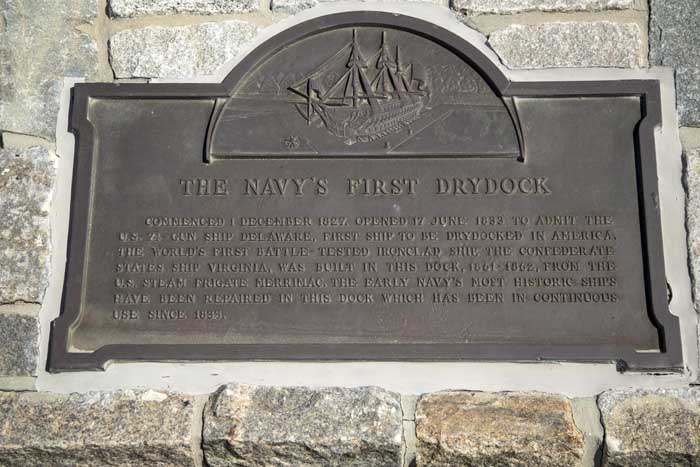
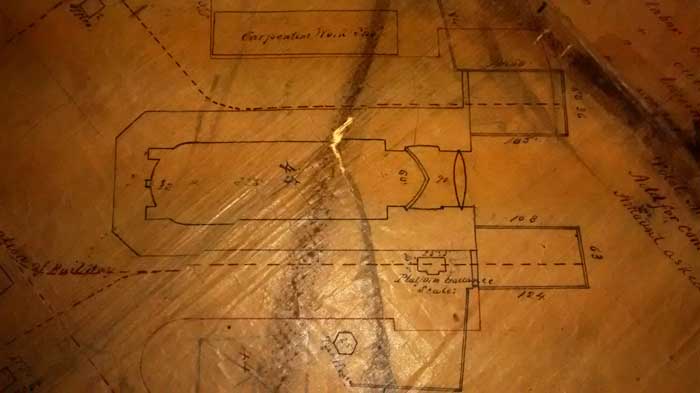
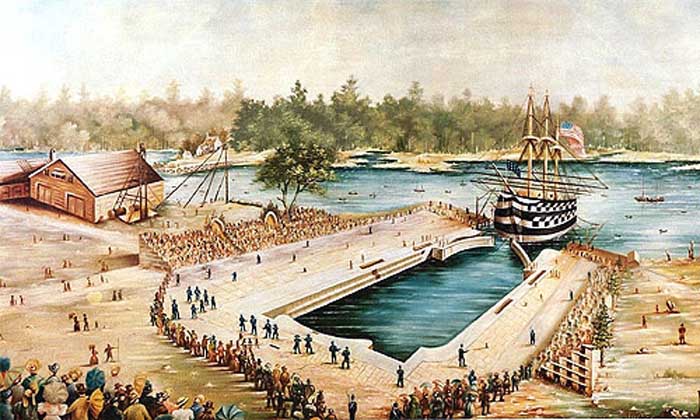
Left: Dry Dock 1 Plaque April 14, 2014
Middle: PNSM Station Map of August 31, 1858
Right: USS DELAWARE 1st Docking in North AmericaJune 17, 1833
Bridges Across The Elizabeth
Travel and transport happens on the Southern Branch of the Elizabeth River. Yet beyond a boat, a ferry, a tunnel, what is left as to not get your feet and goods wet? Yes, a bridge.
Continuing the theme of the Norfolk Navy Yard developing the Schmoele Tract of land and building our present day shipyard in a southerly direction, it is important to acknowledge that our main station’s southernmost boundary has always been defined where the present Belt Line Railroad crosses the river.
We all have seen this railroad bridge in its current configuration, a normally raised structure that lowers when the train needs to cross and then it returns to the raised position to allow waterway traffic to flow. You see it without your mind even considering it, it is just there. Well did it always look like that? No.
Consider the prior railroad bridge was a swing-type bridge as viewed by our photo archives (Historic Norfolk Navy Yard Glass Plate Collection, #2627 taken on June 1, 1920 that focuses on the dredging of Slip #4 which was on the south side of the now demolished Pier #4 of which this image shows in progress. Again I love the human nature of these early construction sites and yes, that is an open bottom privy on the foot path to the dredge machine, but I digress. Anyway, so much was going on at that time even after World War I, yet rail traffic overcame the challenges of the Elizabeth even back in the day. This is our best view of the complete Beltline Railroad swing railroad bridge although it was not the central focus of this image.
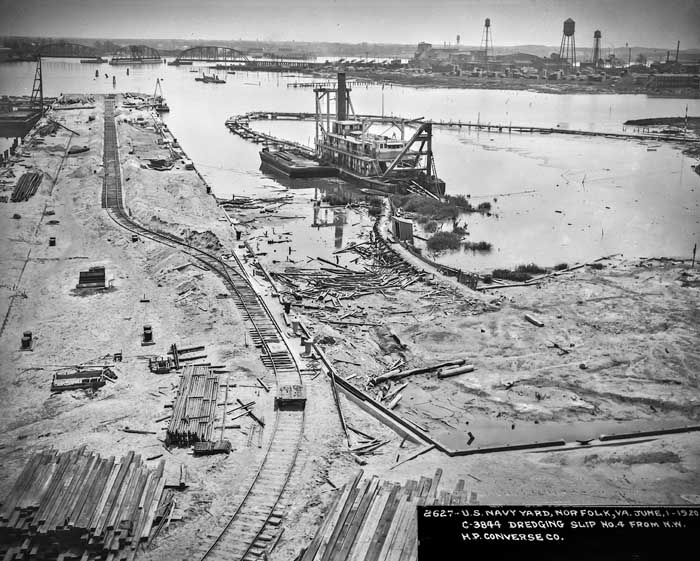
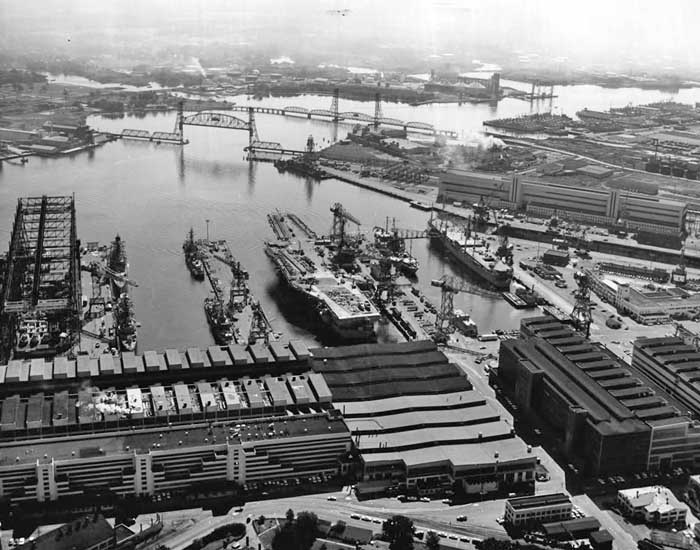
Left: Dredging Slip 4, looking south east. Note the Beltline Railroad swing bridge in distance.
(Historic Norfolk Navy Yard Glass Plate Collection, #2627 taken on June 1, 1920)
Right: Wire photo, December 1966, looking south east, courtesy of M. W. Robbins collection.
Note the "old" Jordan Bridge (lowered) and the modern center lift Beltline Railroad (raised) bridges in distance.So most of us traveled across the "old" Jordan Bridge one time or another that carried Virginia State Route 337 vehicle traffic across the Elizabeth River with a similar center lift draw. While it does not appear in the above mentioned 1920 image, this bridge claims it beginnings to the year of 1928 as it was privately built and operated till November 8, 2008. It also carried to its grave the claim as Virginia’s oldest drawbridge. It is said that this Navy Yard from time to time was called upon to cast machine parts for the bridge company due to its extreme age. The "old" Jordan Bridge was always of vital importance to insure transport our work force. It was finally replaced by the current "new" South Norfolk Jordan Bridge on October 27, 2012.
I include a wire photo from my own collection that shows the Shipyard from the air in December 1966 to which I call your attention of no industrial area fence line for one thing, but please focus on the two older bridges beyond in the background looking south east and contrast them also from a similar timeframe image taken from the air looking northward. The Elizabeth River has been crossed for over a century by both rail and vehicle traffic bridges because – "history matters".
Postcard, aerial photo circa 1966, looking north up the Elizabeth River.
Note the "old" Jordan Bridge (lower foreground) and the modern center lift Beltline Railroad bridge nearest to Shipyard.Construction Progress of Dry Dock #4 – 98 Years Ago
Dates seem to matter more when you can say this happened "X" number of years ago. Couple that with familiar surroundings such as our various shipyard facilities and, as I have said before, you too can have your own "visions of the past."
At one time our Dry Dock # 4 was the largest concrete structure in the world. Add to that it was begun on January 8, 1917, and declared complete on April 1, 1919, as it was urgently needed to support what we now refer as World War I. This notable facility started its long proud history with its first ship docked, the USS Wisconsin on May 5, 1919.
Let those dates sink in and reread the above paragraph again. Twenty-seven months to construct Dry Dock #4 and it was with a lot of sheer manpower and very crude lifting devices compared to what we have in modern times. This dock if nothing else represents what a nation can do when it is mobilized towards a common goal.
I offer three photo images all taken on July 3, 1918, exactly 98 years ago today. One image is focusing on the circulating pipe loop from the Power Plant, another shows a pipe beneath a portion of the now twenty foot thick concrete floor of Dry Dock #4 and finally an overview of the unfinished construction from the secondary inner caisson seat looking west towards the head of the dock. It was not the most organized site but remember they were working under war time conditions and things were different back then.
In the background of that westward looking image, one can view the unfinished Building 163 Structural Shop, Marine structures M-1, M2 & 3, and M-4 & 5 (left to right) and the iconic Building 174 Power Plant with its early steel framing progress. As I have stated before, as we take this journey looking back upon the largest single growth to date of the Shipyard at the World War I timeframe there was a need to support the every growing Navy fleet and this Shipyard again proved itself as critical to help win the war on the home front because – "history matters".
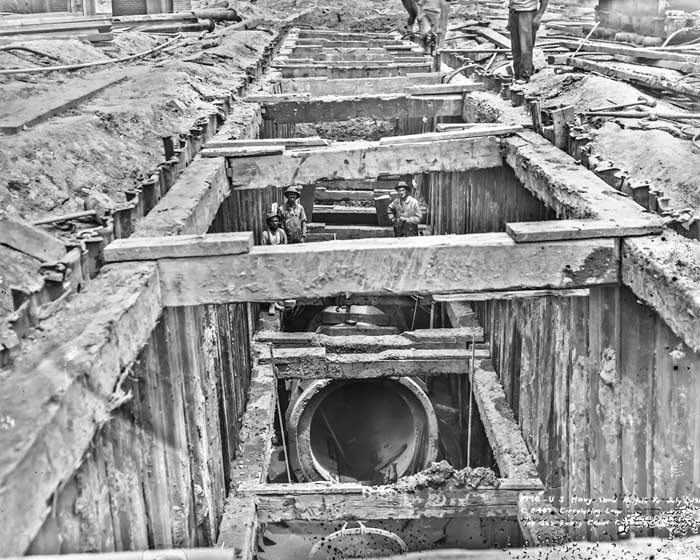
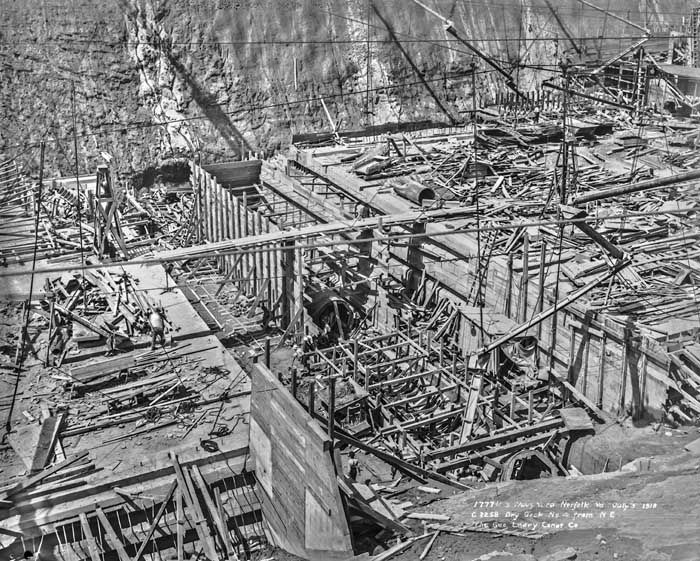
Left: Circulating Loop from Power Plant to the river, construction progress.
(Historic Norfolk Navy Yard Glass Plate Collection, #1776 taken on July 3, 1918)
Middle: Floor of Dry Dock #4, construction progress.
(Historic Norfolk Navy Yard Glass Plate Collection, #1777 taken onJuly 3, 1918)
Right: Dry Dock #4 looking West, construction progress.
(Historic Norfolk Navy Yard Glass Plate Collection, #1778 taken on July 3, 1918)The Bronze Plaque at Gate 10 & Forward
Today my friends at the Portsmouth Naval Shipyard Museum posted a "Throw Back Thursday" photo of the flag pole in what we call 4th Street Park with a 48 star flag. In the center of the image was the rear of the bronze plaque, one of my all-time favorite artifacts that is located just inside of Gate 10 on the grounds of America’s Shipyard. What amazed me is that I had never seen this photo in the thousands of images I have viewed over the last decade. I feature that image within this posting but want to emphasize the importance of the plaque text because every day people ask me about the basic history of our Shipyard and most of it is right there if they take time to seek it out. I am amazed by the number of our employees that have no basic knowledge of how important this location has been for supporting our Navy these last 250 years.
View to the east of 4th Street Park with 48 star flag.
(Image Courtesy of The Portsmouth Naval Shipyard Museum, taken April 1950).The following uses some of my text of May 12, 2014, from a prior History Matters blog with a few updated comments added at the end and a call to action challenge for your input.
As a historian and archivist attempting to tell the story of our great institution, I am often approached by both new and old employees wishing to know more about where they work. It is an honor that I don’t take lightly as to portray our historical past accurately is to lay the groundwork for our future. To read and recite facts coldly is one thing but to be able to tell our story often from memory and point out a specific building, area of grounds on the modern shipyard, a certain set of conditions and then to be able to paint a picture in the employees mind of "that’s where they did this" brings a certain satisfaction when you see their faces. Only then they are able to buy in and own it too.
Our Norfolk Naval Shipyard lives on today because of the proud accomplishments of not only its past but its promise of the future. It is so very important that new employees here learn of the great milestones we accomplished here on the southern branch of the Elizabeth River, not only for the Navy but for the United States. The one thing I try to tell everyone is history is not just something abstract that happened in the past. The history of our shipyard going into the future depends on you also, the new employee. "You must own it".
The historical events of the Norfolk Naval Shipyard are like a great tapestry; it is woven of many individual fibers all coming together to create something larger. Those fibers begin with our people as they demonstrate pride, knowledge and the craftsmanship of the shipbuilding and repair. Those fibers are the tools used and raw materials that are transformed into ships and equipment. Those fibers are the facilities and buildings that are utilized to bring everything together in order to deliver a world class product.
Norfolk Naval Shipyard delivers world class products as evidenced by our motto – "Any Ship, Any Time, Any Where".
One of the best physical artifact tools for learning and teaching a quick overview of our historical events at the Norfolk Naval Shipyard is the bronze plaque inside of Gate 10. I often take new employees there or advise the more seasoned ones to take time to go read what they have driven past for years. It was erected by the Norfolk Naval Historical Association in 1950 with the very mission of telling our story.
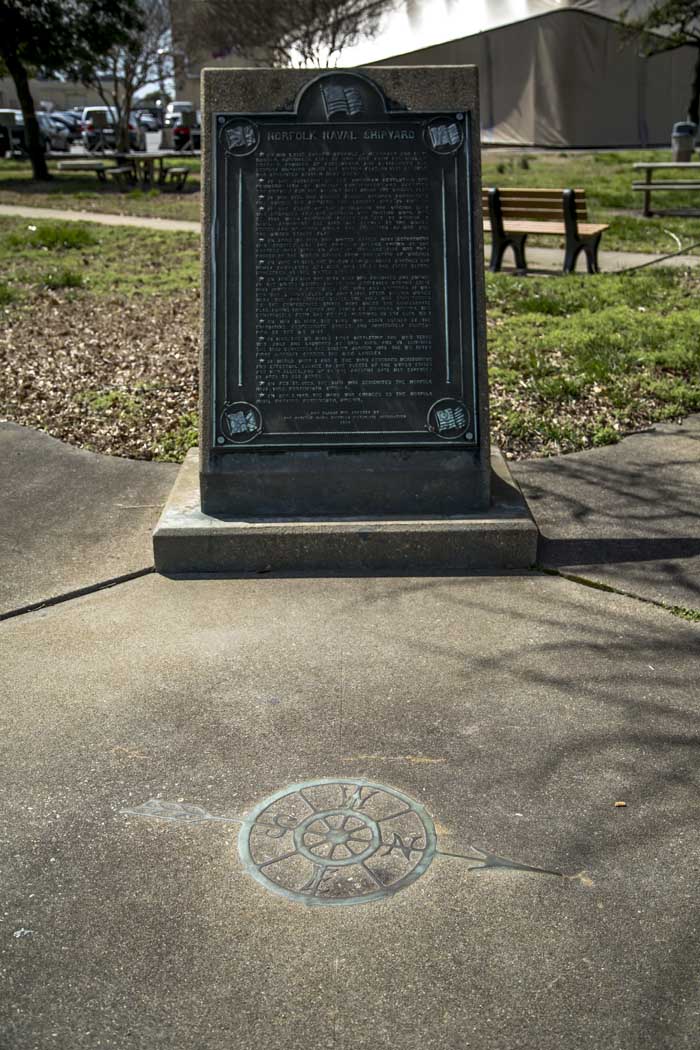
Left: Gate 10 Park Bronze Plaque. Image taken on March 27, 2014, Navy photo.
(Plaque Erected By The Norfolk Naval Shipyard Historical Association, 1950).
Right: Image of Gate 10 Bronze Plaque.
(Text sourced from "A Brief History" by Marshall W. Butt April 1951).If you read the above text carefully you will learn of the four flags this yard has had flown from its flagstaff (British, Virginia, Confederacy & United States) and you will also learn of the three different burns (1779, 1861 & 1862) of the shipyard. From the first dry docking in 1833 of a ship in the United States (USS Delaware), our Drydock 1 still remains in operation today and is a testament to the craftsman that built it. Other facts contained on the plaque high lite the conversion of the ironclad (CSS Virginia) which was important because it helped changed modern naval warfare, it too can trace its heritage to Drydock 1. The US Navy’s first Battleship (USS Texas) and the first aircraft carrier (USS Langley) also were constructed here. Finally the plaque gives the various specific dates that this great institution underwent in its formal name changes.
The last entry on the current bronze plaque is December 1, 1945, being our name change to The Norfolk Naval Shipyard. Today in 2016 that is over 70 years ago, have we not made history since then? What do you think are the worthy big rock type events that could milestone our history from 1945 to present? You know how to reach me so please help fill in the last seven decades of "our" story. I respectfully request your input from the deck plates as the sign in Shop 11 once said "The most important employees are the ones with toolboxes". Please let me hear from you because – "history matters".Construction Continues on Dry Dock #4 – 98 Years Ago
Today marks my 57th birthday, so how fitting it was that I was able to find in the Historic Norfolk Navy Yard Glass Plate Collection a glass plate that shows a progress image of the ongoing construction of our Dry Dock #4, exactly 98 years ago today.
Dry Dock #4 looking to the West, construction progress.
(Historic Norfolk Navy Yard Glass Plate Collection, #1788 taken on July 24, 1918)
Power Plant, Building 174 in middle ground. Marine Commandant's Home, M-1 in far distanceToday I am not going to focus on any of actual construction details of Dry Dock #4 excect to share a very rare image of the ongoing construction of a structure that has served the United States Navy for almost a century. Also I am going to spend the remainder of this column personally reflecting on things I see in the image because it is my birthday.
I have touched upon various fun facts and construction details with my prior "History Matters ~ Visions of the Past", blogs #5, 21 and 30 pertain specifically to Dry Dock #4 as found here along with all of my original writings from the very beginning on January 31, 2011. Enjoy, but please respect the copyright. This entire collection is my labor of love to freely share our shipyard heritage so others may know.
http://www.usgwarchives.net/…/po…/shipyard/nnyblogindex.html
Anyway, the progress image appears to be very chaotic, yet any construction site is somewhat in turmoil before the finished product is ready for final use. When I look upon this image from the Historic Norfolk Navy Yard Glass Plate Collection, #1788 taken on 7/24/1918, it takes me back in time to personal experiences with Dry Dock #4 and also the buildings in the background even though it taken 41 years prior to the date I was born.
On the left, the large Pump Well structure is being formed with a cross section of the flooding flume on the southern dock wall. Within both of these areas, I have walked back in the 1980’s when I was a Public Works Planner & Estimator. Talk about a dungeon appearance and strange feeling. Those that have been in these places will be able to relate to these thoughts because there is no daylight, only dark spooky dampness.
In the middle ground distance is the Power Plant, a place where as a Public Works Shop 07 Pipe Welder I worked for many years. Believe it or not, 130 pounds and blonde hair to my shoulders I came in making a whopping $4.20 an hour and never had so much free cash. There is nothing at all wrong with learning a trade and working hard. I am reminded of a banner that once was inside of Shop 11 back in the day – "The most important employees are the ones with toolboxes." Without the waterfront guys, we would be nothing.
In the extreme background is the old Marine Commandant’s home, M-1. It was my office, historical display location and responsibility to run the Executive Support Conference Center until retirement as the Command Facilities Manager for Code 1100. A lot of history has happened under that roofline that dates to 1905, and, for a final fun fact, it still has its original slate shingles.
Ok, so I went off subject a bit today, but in closing please focus on what we take for granted today with the smooth concrete surfaces of Dry Dock #4. Construction is messy at times. Capital construction projects such as Dry Dock #4 positioned us to support the World War I needs of the United States Navy because – "history matters".